Music is the universal language
“Glory to God in the highest heaven, and on earth peace to those on whom his favor rests.” - Luke 2:14
Premier Guitar
Sowing in the Storm with "Ecstatic Black Metal" Band Agriculture

Los Angeles experimental metal band Agriculture’s new record, The Spiritual Sound, might not make sense to you at first listen. When the band sent the album to their friends, many of them were overwhelmed, if not weirded out. The band members weren’t surprised. “If I heard this record for the first time, I’d be pretty confused by it,” says guitarist and vocalist Dan Meyer.
The record opens with clanking bass strokes before a dizzying hornet’s nest of guitars and drums careens around maniacally for 20 seconds. After that, a brutal downtuned riff kicks in, accompanied by face-melting shredding. By the time the song hits the one-minute mark, and vocalist/bassist Leah B. Levinson’s dungeon-creature scream rips across the track, there have been three distinct movements. There are four more minutes, and a few more movements, to go—including a beautiful melodic reprieve that’s reprised near the song’s final moments.
It’s a thrilling shot across the bow from one of heavy music’s most fearless acts. By the end of The Spiritual Sound, Agriculture have extended their tongue-in-cheek genre designation of “ecstatic black metal” into regions like powerviolence, noise, alternative, shoegaze, and sounds that touch on folk and traditional. “Dan’s Love Song,” for example, with its nostalgic melody and simple chord progressions, could be a noise-rock interpretation of some obscure 1800s ballad. (The band lists Metallica, Slipknot, the Jesus and Mary Chain, and Bob Dylan as primary influences on the new album.) “Bodhidharma,” meanwhile, flips on its heel between headbanging metal and passages of silence, punctuated by screams, whispers, and Haug’s frozen, hulking snare and kick bursts. It also features some of Chowenhill’s most mindboggling lead guitar passages.
“The problem that I was trying to solve with my songwriting on this record was, ‘How do I write about things as they occur in my life without overly dramatizing them?’” —Leah B. Levinson
Formed in the early days of the pandemic, Agriculture—Levinson, Meyer, guitarist Richard Chowenhill, and drummer Kern Haug—have defined their sound as something that is once experimental, abrasive, and jubilant. The record title and the band’s self-determined genre designation hail from a jokey remark lobbed at them: “I love the spiritual sound of this ecstatic black metal.” The phrase, and the band, are the subject of debate on various heavy-music forums. There is a certain sense of Ursula K. Le Guin’s world-building at play in Agriculture’s music—a playfulness, curiosity, and seeming inhabitance of an alternate reality.
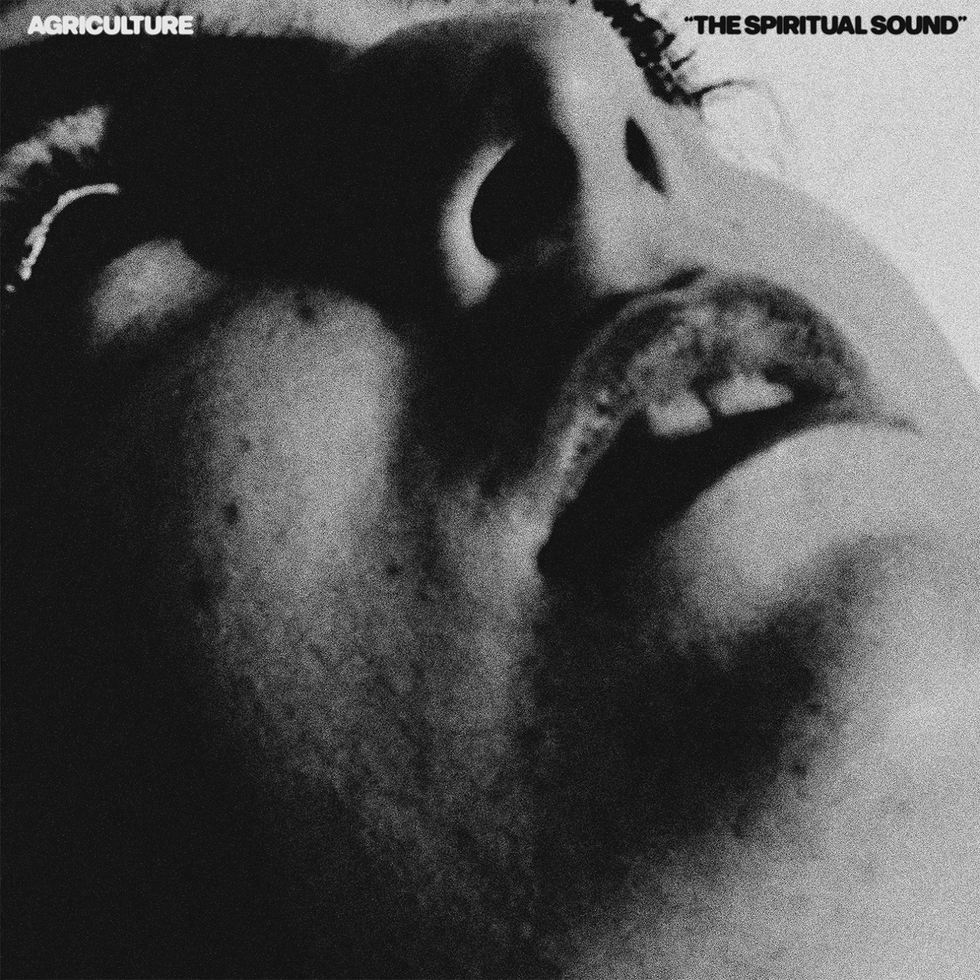
The band’s writing process for The Spiritual Sound was “unusually collaborative,” says Meyer. Songs were brought in fully formed, then torn apart and reconstituted, often with different parts. Meyer likens it to building a character at the outset of a role-playing game. “The head of this song ends up going with the body of that song,” he quips.
Once songs were solidified, they were taken to what the band calls “Richard’s kingdom”—the affectionate term for Chowenhill’s studio, where deep production began after principle tracking. That’s where vocals, overdubs, and “ear candy” were added. It’s also where plenty of sparring took place. “It is a more adventurous record,” says Levinson. “We make a lot of capital-C choices on it, and it really did require us setting aside creative differences, or at least sitting with things and being like, ‘I don’t know where this is going, I don’t like this, but I’m gonna sit with it and trust that each other has a vision.”
Chowenhill, who is trained as a composer in the classical tradition, is responsible for most of the jaw-dropping guitar theatrics on the record, influenced by shredders like Alexi Laiho and Eddie Van Halen alongside Hungarian composer György Ligeti—in particular Ligeti’s “String Quartet No. 2.” “There’s no guitars, but you can transpose those things to guitar,” he explains, naming the composition’s chromatic motion and left-hand techniques as things he considered while composing leads. His tremolo picking, in particular, is astonishing. That comes from worship of heroes like Van Halen, but also mandolin players like David Grisman and Chris Thile.
“We’re in this weird era right now where it’s actually more rare to not be hearing musical sound than it is to be hearing it.”—Dan Meyer
While Meyer drew Zen Buddhism concepts into the record on songs he composed, Levinson took inspiration from literature produced during and after the AIDS epidemic in the U.S., especially David Wojnarowicz’s Close to the Knives: A Memoir of Disintegration, a collection of essays reflecting on the crisis. Poet Ted Berrigan’s classic The Sonnets was also in view. They spurred Levinson’s lyricism toward “looking at suffering and spirituality in a quotidian sense”—an interesting exercise on a record of volatile music.
Leah B. Levinson’s Gear
Basses
Ibanez SR505E 5-string
Ernie Ball Music Man Sabre
Amps
Ampeg SVT-4 Pro head
Peavey 2x15 cab
Effects
Ibanez Pentatone Gate
One Control Mosquito Blender
One Control Black Loop with BJF Buffer
MXR M306 Poly Blue Octave
Electro-Harmonix Green Russian Big Muff
Catalinbread Carbide
Electro-Harmonix Canyon
Old Blood Noise Endeavors Haunt
Darkglass Microtubes B7K V2
Strings & Picks
Ernie Ball Regular Slinky Bass 5 strings
Dunlop Tortex Flow 1.5 mm picks
Dan Meyer’s Gear
Guitars
Custom Jazzmaster copy
Amps
Peavey 6505+ (studio)
Fender Blues Junior (studio)
Orange Pedal Baby 100 (live)
Randall Diavolo 4x12 cab
Effects
Line 6 Helix LT
Strings & Picks
Ernie Ball Skinny Top Heavy Bottom strings
Dunlop Max-Grip Jazz III picks
Richard Chowenhill’s Gear
Guitars
EVH Wolfgang HT
Amps
Peavey 6505+ (studio)
Fender Blues Junior (studio)
Orange Pedal Baby 100 (live)
Randall Diavolo 4x12 cab
Effects
Morley Steve Vai Mini Bad Horsie
Line 6 HX Stomp
JHS Muffuletta
Strings & Picks
Ernie Ball Regular Slinky strings
Dunlop Primetone Triangle Grip 1.4 mm picks

“I think when you’re working in extreme music, so much of the impulse is, ‘I have to talk about something extreme and I have to be dramatic, I’m gonna be screaming these words, they need to be about intense and immediate suffering and violent images,’” says Levinson. “The problem that I was trying to solve with my songwriting on this record was, ‘How do I write about things as they occur in my life and in my world without overly dramatizing them or without making them too much of a spectacle? Not presenting spectacles of suffering, but just how things exist in the everyday.”
“We pose this record as a rejection of ‘the vibe,’ but on the other side of that, it’s an invitation. It’s an invitation to listen, to just sit and be with us for a while.”—Richard Chowenhill
The ordinary, unremarkable facets of life, more than anything, are at the heart of Agriculture’s approach to making music—especially when it comes to the consumption of art. “We’re in this weird era right now where it’s actually more rare to not be hearing musical sound than it is to be hearing it, right?” says Dan Meyer. “We hear it everywhere, at every restaurant, in the grocery store, in the car. I think Spotify is bad. I think that flattening music into something that people just think of as sonic perfume is negative for music as a practice, both artistically and spiritually, and for us as listeners.”
“When we were writing these songs,” continues Levinson, “it’s not like we were thinking, ‘We’re gonna make some anti-vibe music.’ I don’t think that would sustain the compositional practice. A lot of these songs were really written with a mind towards live performance. I think people are pretty engaged when they’re watching us and it’s sort of a what-are-they-gonna-do-next-type thing.” Levinson says Agriculture’s work isn’t exactly “body-moving music” in the way that more groove-oriented metal is. “That’s not the show we’re selling. It’s like, stand there and look at it and be confused for a bit, and be interested and be excited, and go through some emotional experience.”
Meyer parallels the experience with the way that kōans, the reflective prompts of Zen Buddhism, demand attention. “I think that’s kind of what we’re going for,” says Meyer. “It’s like we’re waving our hands a little bit, like, ‘pay attention.’”
Chowenhill’s classical bonafides certainly contribute to the cinematic scope of Agriculture’s music. It also lends the sort of compositional depth that rewards repeat listens. “We pose this record as a rejection of ‘the vibe,’ but on the other side of that, it’s an invitation,” he says. “It’s an invitation to listen, to just sit and be with us for a while, as long as you’re willing to be here.”
Jimmy Herring: ARU, Panic, and Beyond | 100 Guitarists Podcast
This week, hosts Nick Millevoi and the shamelessly biased Jason Shadrick dive deep—much, much deeper than Nick ever imagined he would go—into the vast discography of the great Jimmy Herring. They enlist Rob Compa, formerly of Dopapod and now of Neighbor, whose greatest qualification is living in Burlington, Vermont, "the hub of all things jam bands".
Maybe you’ve heard Jimmy Herring is amazing, but the sheer "jam-ness" of his output is intimidating. We systematically go through Herring’s entire discography and in the process ruin Nick’s Apple Music algorithm. But common ground was found in Frogwings' Croakin’ at Toads, which found a new fan in Nick even though he’s slightly John Popper-phobic. Rob chimes in on his favorite nuggets from the catalog and discusses what exactly makes Herring gain such a fanbase among guitar nerds. Is it Jazz Is Dead, Phil Lesh, the ferocious McLaughlin collaboration? Plus, we decide that Herring’s “Scapegoat Blues” might be an all-time jam-band standard and required repertoire for any aspiring guitarist.
Thanks to our Sponsor Rocky Mountain Slides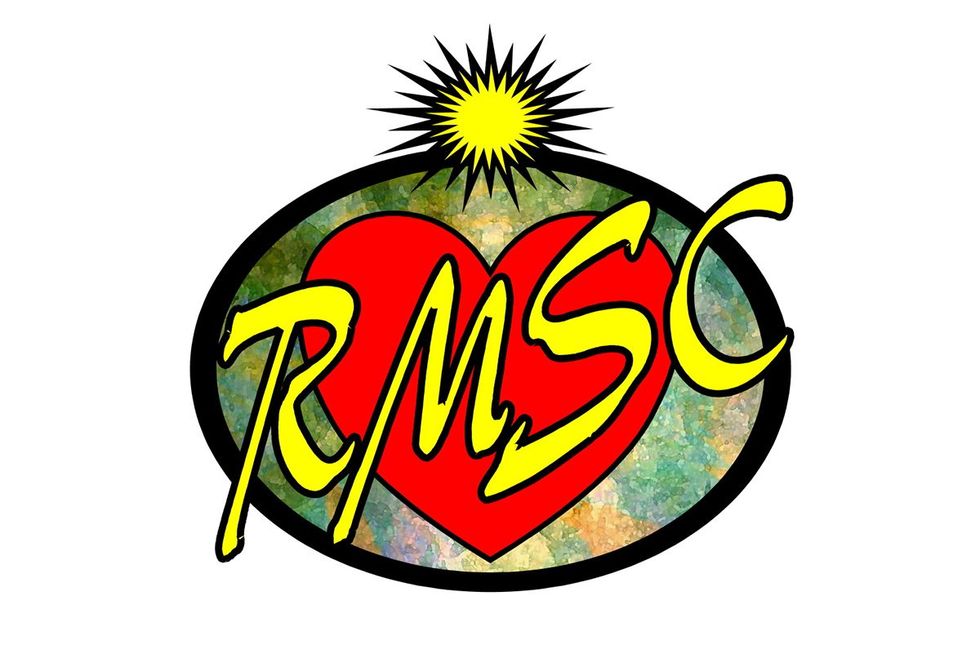
Learn More! rockymountainslides.com
Ashdown Launches UK-Built Cabinets and Amps
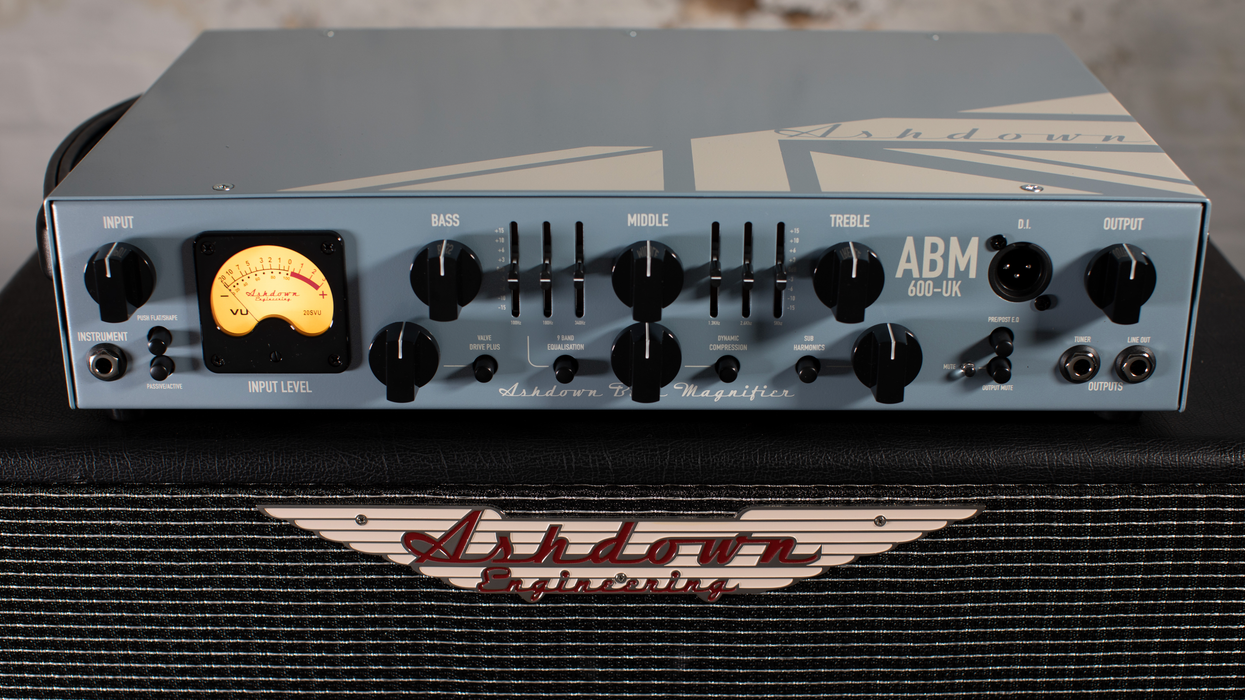
Ashdown Engineering has launched new amp and cabinet models to its flagship ABM range, now available in fully UK-built editions.
For over 25 years, the Ashdown ABM series has earned its place on some of the world’s biggest stage, trusted by professional bass players for its signature tone, flexibility, and reliability.
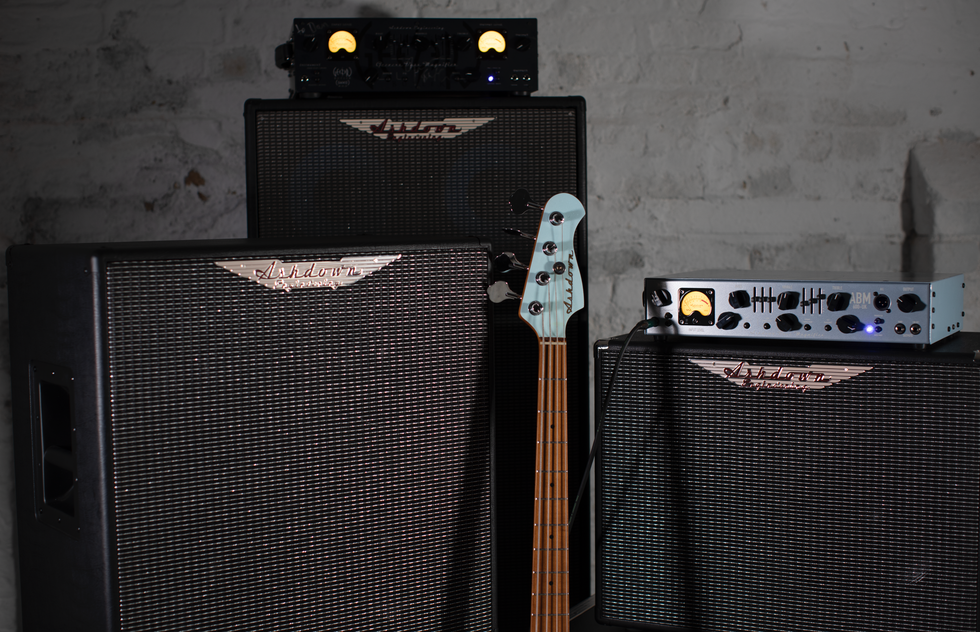
The new amps include the UK-ABM-300-EVO IV and UK-ABM-600-EVO IV. The cabinets include five newly re-engineered cabinets blending iconic ABM tone with state-of-the-art materials and superior construction, crafted entirely in the UK. The five models include the UK-ABM-810H-EVO IV, UK-ABM-410H-EVO IV, UK-ABM-210H-EVO IV, UK-ABM-115H-EVO IV and UK-ABM-112H-EVO IV.
Here are details on the two new amps. Delivering 300 watts of pure bass power, the UK-ABM-300-EVO IV combines heritage tone with modern control. Its class-leading preamp features the Variable Valve Drive Plus, giving players access to a broad tonal spectrum, from warm cleans to gritty overdrive, all foot-switchable for performance versatility. A brand-new 9-band EQ offers pinpoint tonal shaping, while the One Knob Compressor and Sub-Harmonic Generator ensure your bass remains rich, tight, and stage-ready. Professional connectivity, including FX loop, Line Input, and tuner out, make it a complete solution for live and studio applications.
For players demanding more headroom and authority, the Uk-ABM-600-EVO IV offers 600 watts of commanding power while retaining the full feature set of its 300W sibling. The enhanced 9-band EQ, signature VU meter, and foot-switchable controls for Valve Drive, Compression, EQ, and Sub-Harmonics allow seamless integration into any performance setup. Built for the modern bassist yet faithful to its roots, the UK-ABM-600-EVO IV represents the pinnacle of Ashdown’s amplifier design.
Amp specifications are as follows:
UK-ABM-300-EVO IV –
- Power Output - 300 Watt
- Speaker Outputs - 2 x Neutrick Jack/Speakon outputs
- Includes DI output, effects send and return
- Impedance - Minimum 4 Ohms
- Pre Amp Tubes - 1 x 12AX7
- H x W x D (mm) - 146 x 488 x 336
- Weight (kg) - 12.5
UK-ABM-600-EVO IV –
- Power Output - 600 Watts
- Speaker Outputs - 2 x Jack/Speakon outputs
- Includes DI output, effects send and return
- H x W x D (mm) - 146 x 489 x 336
- Weight (kg) - 12.5
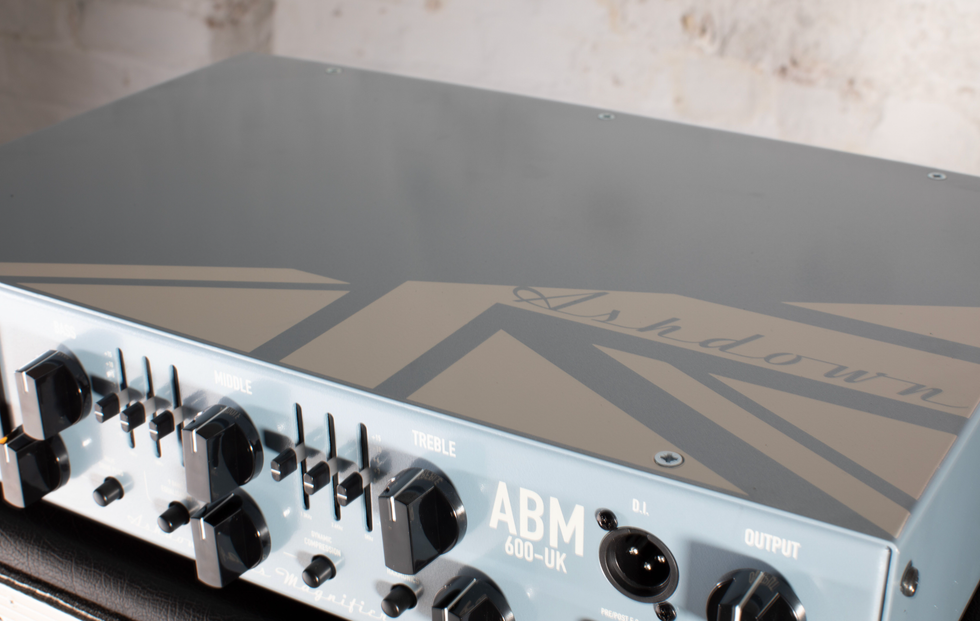
Here are details on the new line of cabinets.
- UK-ABM-810H- EVO IV, a powerhouse cabinet designed for commanding the largest of stages. Loaded with eight precision 10” ceramic drivers arranged in sealed chamber pairs, the UK-ABM-810H-EVO IV offers unmatched punch and midrange articulation. With a massive 2000W AES power handling and a switchable high-frequency horn, this is a cabinet built to deliver, night after night.
- UK-ABM-410H-EVO IV – A studio and stage staple worldwide, delivering tight response and 1000W AES of focused clarity from four 10” ceramic drivers.
- UK-ABM-210H-EVO IV – Half the size, all the tone. Ideal for smaller gigs or pairing with additional cabs, offering 500W AES.
- UK-ABM-115H-EVO IV – A 500W AES 15” cabinet for players who crave classic warmth and depth.
- UK-ABM-112H-EVO IV – Compact yet mighty, the new 300W AES 12” format is meticulously balanced and is already being heralded as the go-to cab for the range.
All cabinets feature genuine Neutrik Speakon connectors, are rear-ported for enhanced low-end performance, and are constructed from FSC-certified Mahogany plywood (or Latvian Baltic birch for the UK-ABM-810H-EVO IV) for unrivalled resonance and durability.
Cabinet specifications are as follows.
UK-ABM-112H-EVO IV
- AES Power – 300W
- Drivers – 1x12”
- Sensitivity – 98dB
- Impedance – 8 Ohms
- Magnet – Ceramic
- Dimensions (W x H x D) – 603 x 452 x 340 mm
UK-ABM-115H-EVO IV
- AES Power – 500W
- Drivers – 1x15”
- Sensitivity – 98dB
- Impedance – 8 Ohms
- Magnet – Ceramic
- Dimensions (W x H x D) - 603 x 452 x 340 mm
UK-ABM-210H-EVO IV
- AES Power – 500W
- Drivers – 2x10”
- Sensitivity – 99dB
- Impedance – 8 Ohms
- Magnet – Ceramic
- Dimensions (W x H x D) - 603 x 452 x 340 mm
UK-ABM-410H-EVO IV
- AES Power – 1000W
- Drivers – 4x10”
- Sensitivity – 102dB
- Impedance – 8 Ohms
- Magnet – Ceramic
- Dimensions (W x H x D) - 603 x 603 x 340 mm
UK-ABM-810H-EVO IV
- AES Power – 2000W
- Drivers – 8x10”
- Sensitivity – 105dB
- Impedance – 4 Ohms
- Magnet – Ceramic
- Dimensions (W x H x D) - 609 x 1150 x 415 mm
Hand-assembled at Ashdown’s UK headquarters in Essex, these amps and cabinets represent a renewed dedication to in-house engineering and local manufacturing. Every UK-ABM-EVO IV head is crafted with the same passion and precision that has defined Ashdown for decades.
For more information, visit: www.ashdownmusic.co.uk
Gear Finds: Pickups and Guitar Upgrades
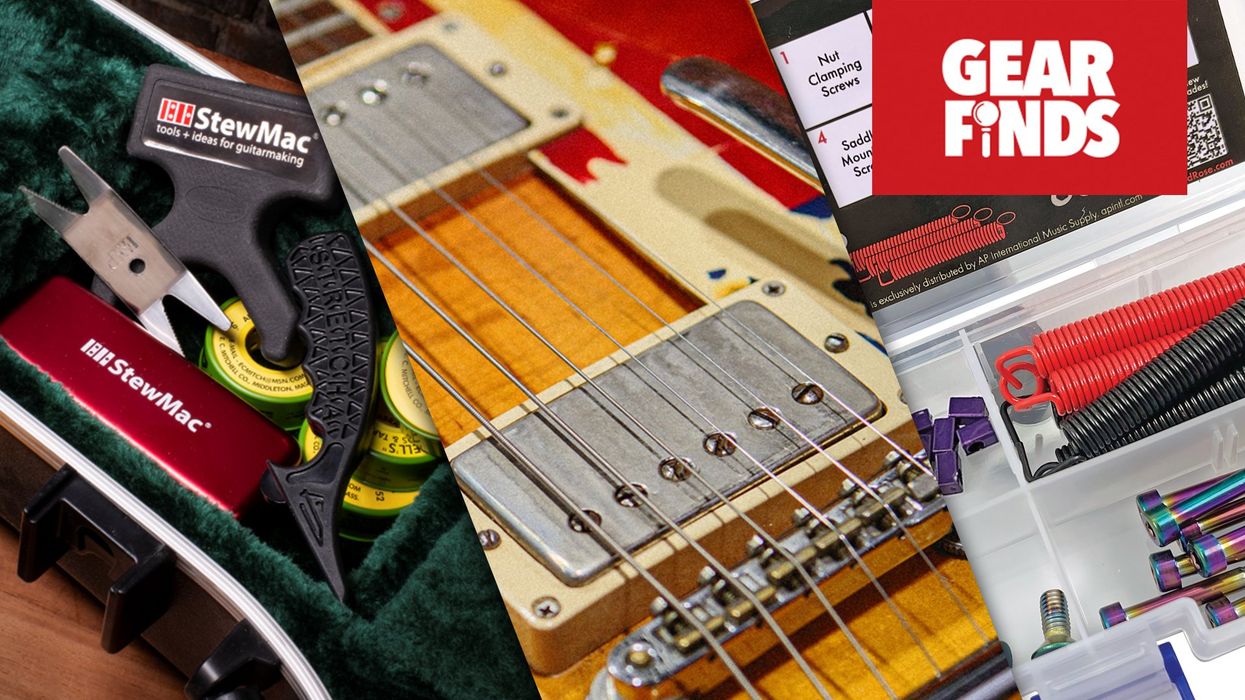
Unlock your guitar's true potential with the Fralin Pickups Push-Pull Blender Pot! Blend tones, split coils, and explore endless sonic possibilities without permanent changes. Ready to elevate your sound? Check out the Joe Bonamassa Humbucker Set and more gear to keep your music alive!
Fralin Pickups
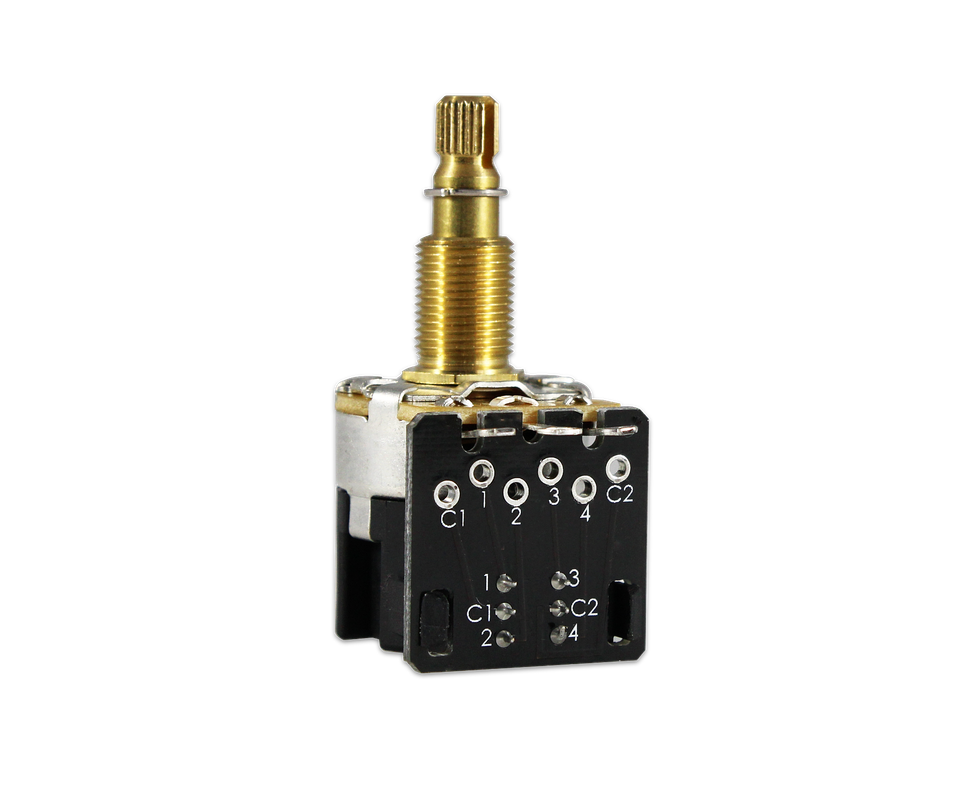
Push Pull Blender Pot
Unlock a wider range of tones with the Fralin Pickups Push-Pull Blender Pot. Compatible with guitars and basses, this versatile control blends pickup outputs, adds coil-splitting and out-of-phase options, and enables many wiring mods—giving you flexible, player-friendly tonal shaping without permanent changes to your instrument.
$25 street
Graph Tech
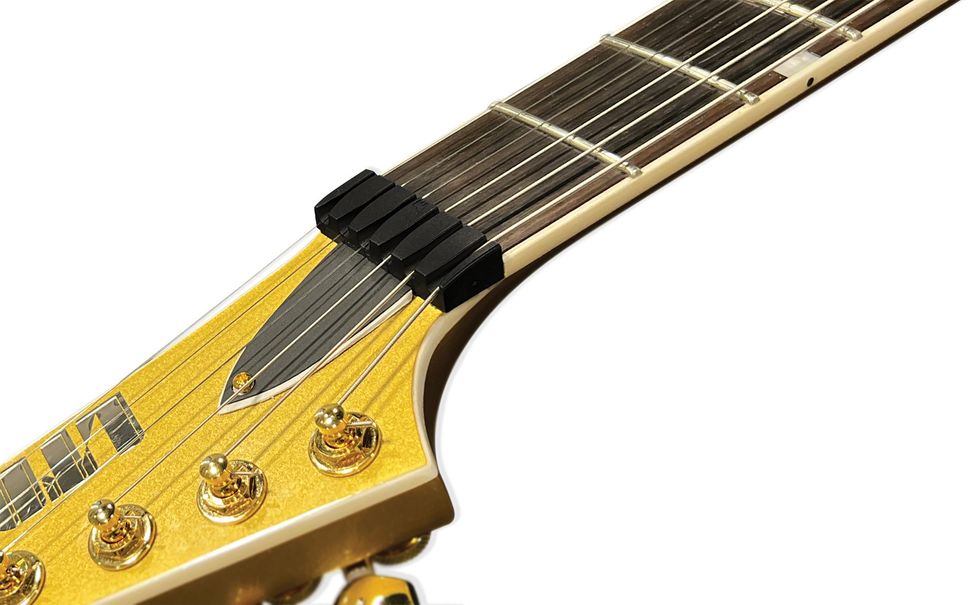
Un-Lock Nut
Unlock your nut and release the beast!
$35 street
Seymour Duncan
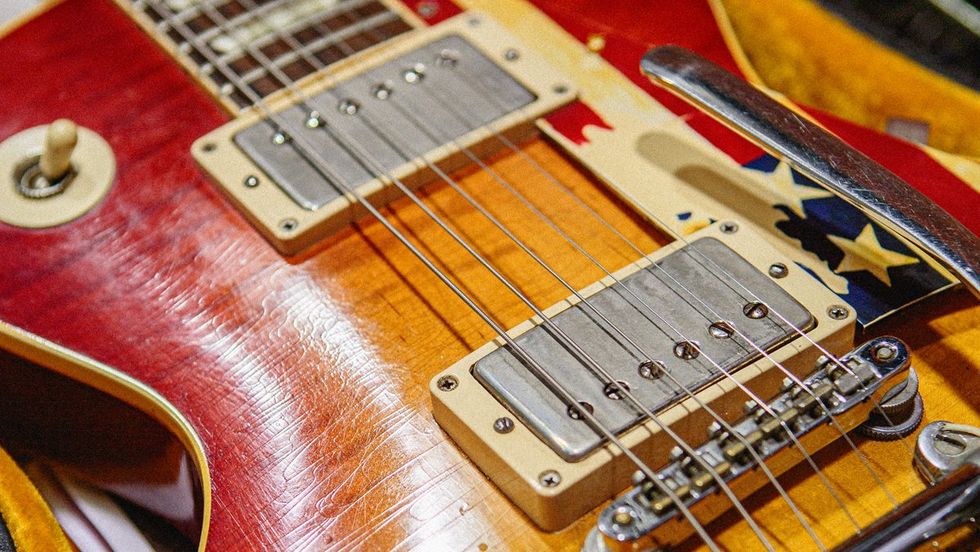
The Joe Bonamassa “Bolin Burst” Humbucker Set
Joe Bonamassa has long been a fan of Tommy Bolin, whose work influenced generations of guitarists. After a 10-year search, Joe acquired Tommy’s 1960 Gibson Les Paul and worked with the Seymour Duncan Custom Shop to recreate these P.A.F.s. The first 500 sets are signed by Joe and Seymour Duncan.
$375 street
StewMac
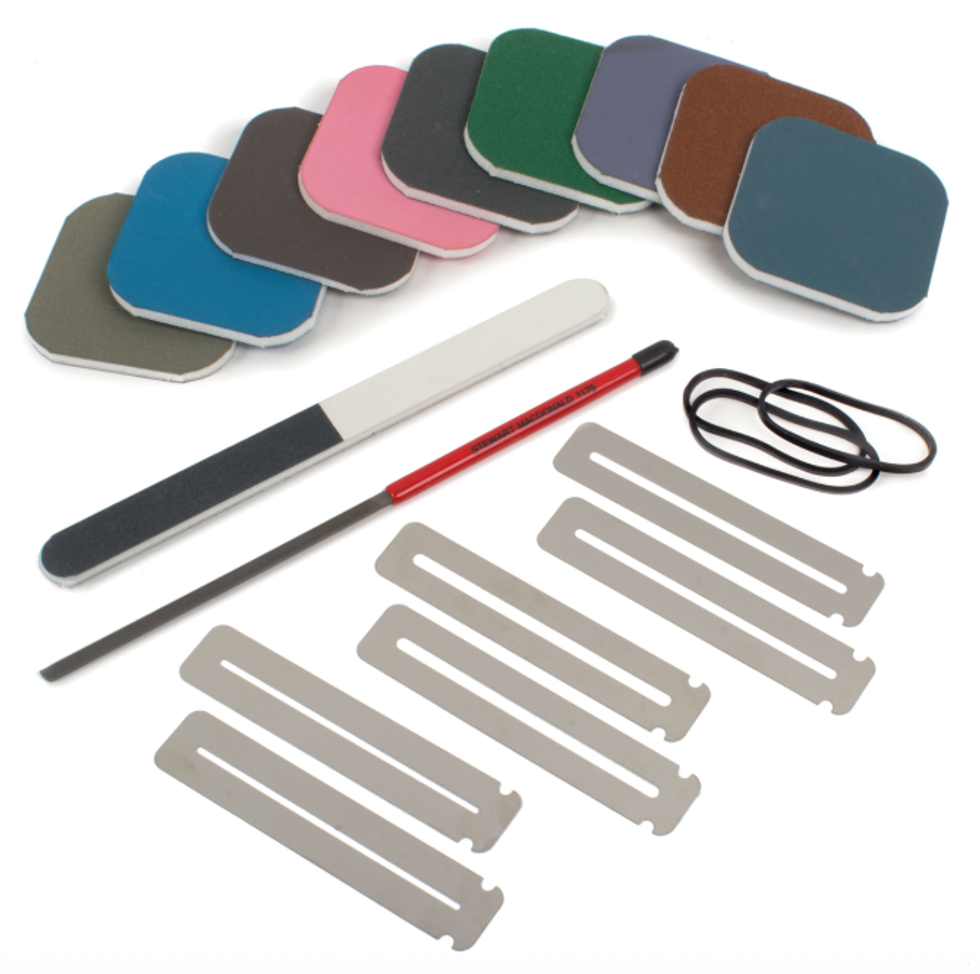
Rough Fret Smooth + Shine Set
Don’t let fret sprout stop you from playing your favorite guitar. This kit has everything you need to fix it yourself. When dry weather comes around, your fretboard can shrink and the fret ends poke out. Sharp fret ends can slow you down, feel uncomfortable, or cut your hand.
$69 street
StewMac
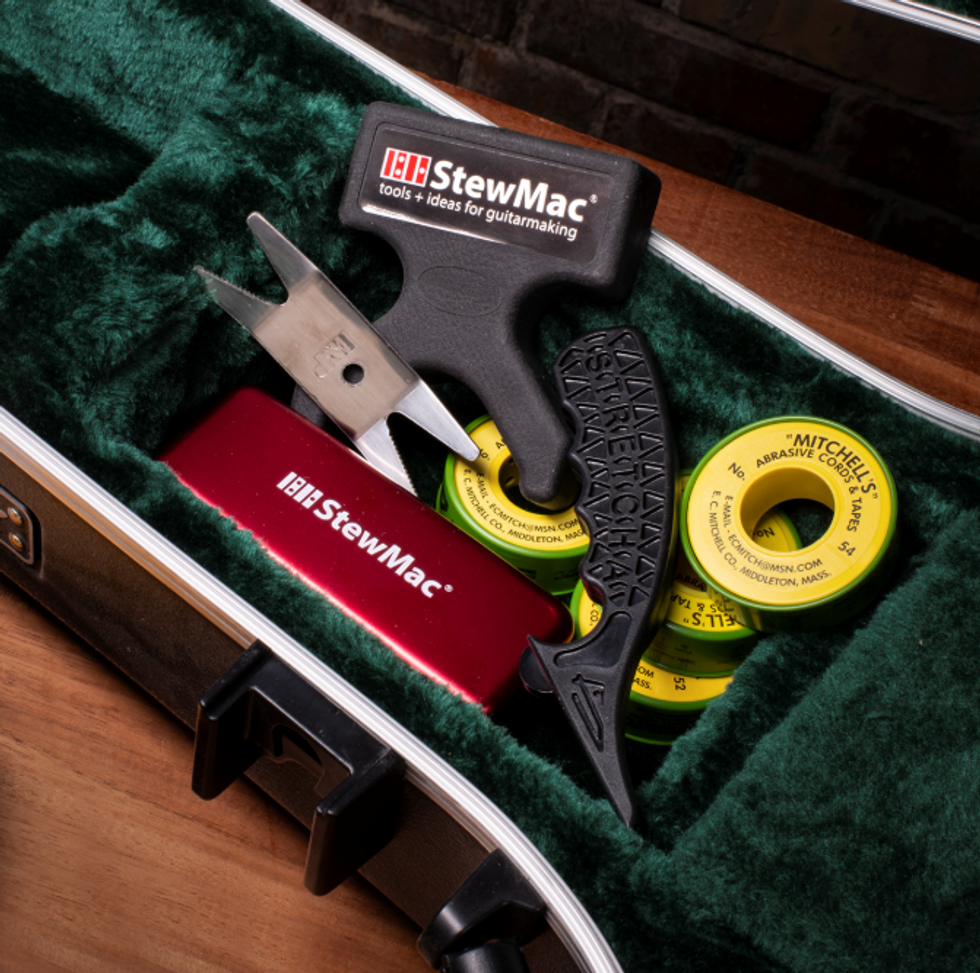
StewMac Guitar Tech Case Candy Set
When performing live, the small problems can turn a great show into a nightmare. A loose screw, slipping string, or guitar poorly leaned against an amp can create major stress. So, we created the Guitar Tech Case Candy Set—a compact collection of essential tools designed to keep your guitar stage-ready.
$140 street
stewmac.comFloyd Rose
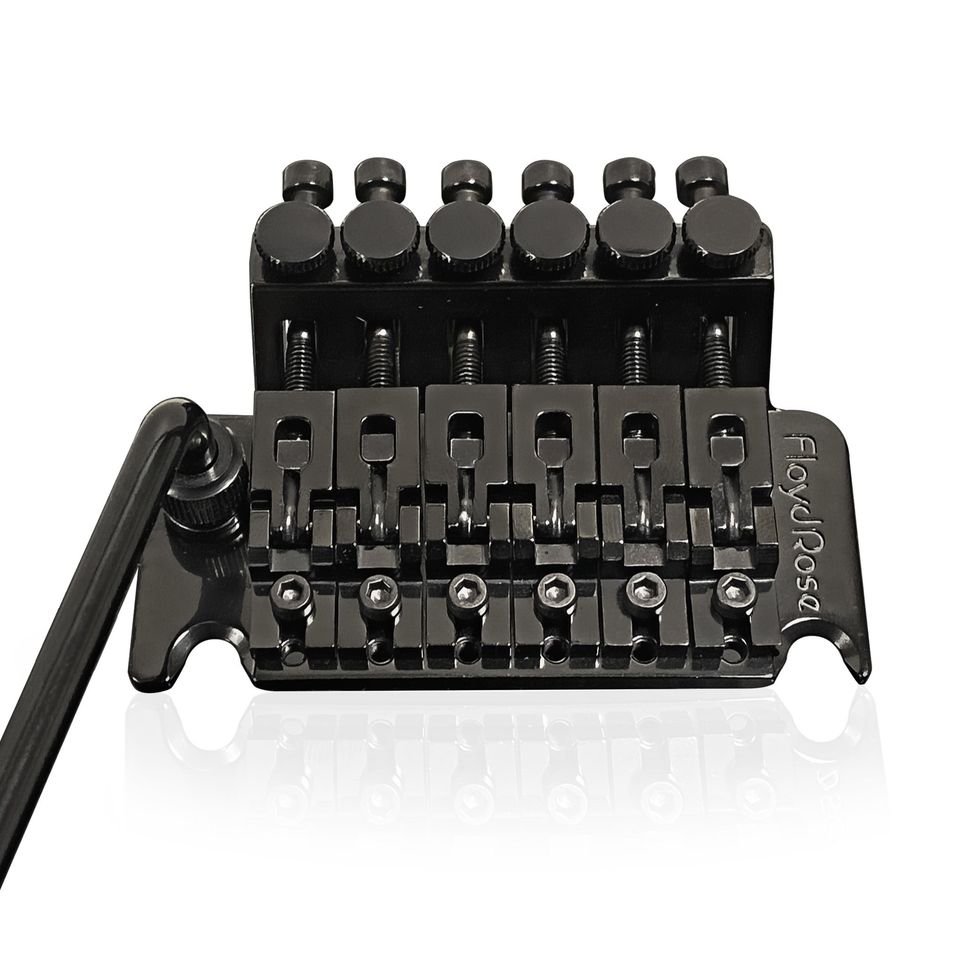
USA Original Radius Saddle Sets
Designed for matching specific fretboard curvatures, Floyd Rose Original saddle sets now offer several radius options without the need for individual saddle shims. Crafted in the U.S. from high-quality tool steel using precision CNC machining, the saddles are then heat-treated and plated to withstand the demands of the heaviest performers.
$110 street
Floyd Rose
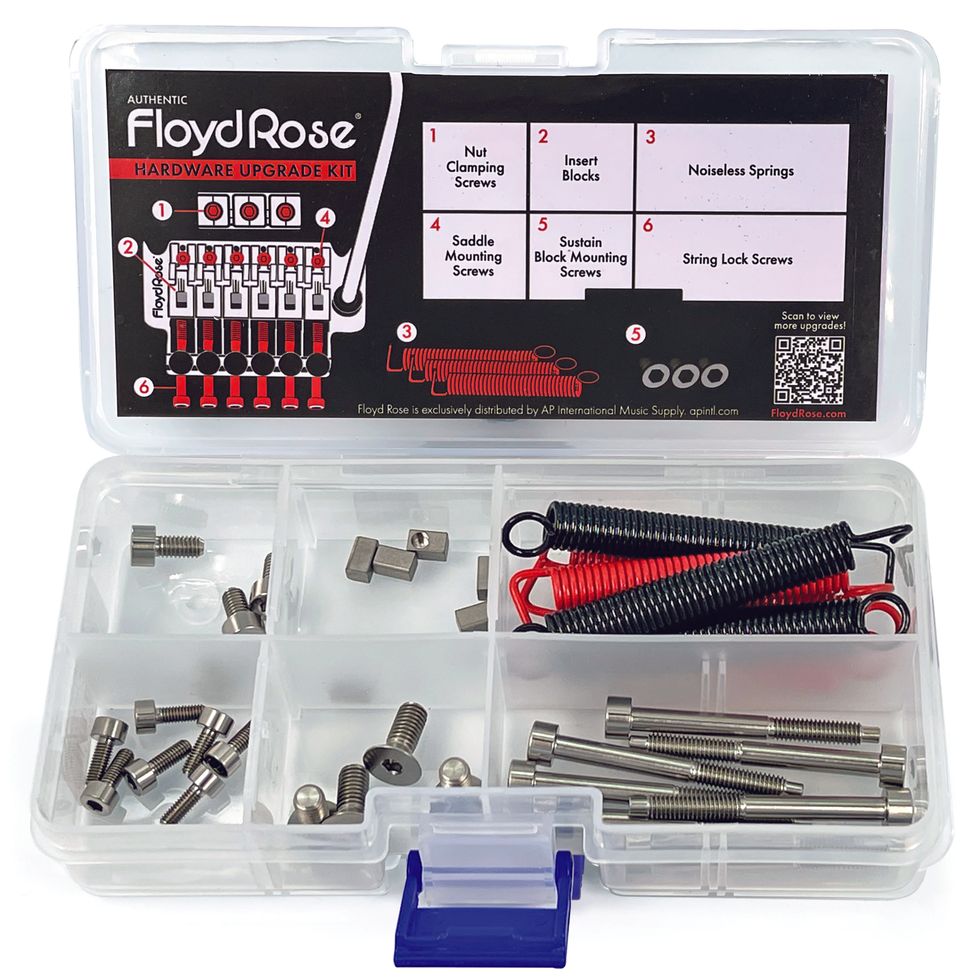
Hardware Upgrade Kits
Introducing authentic upgradable hardware kits for FR Tremolo Systems, available in eight stainless steel finishes as well as titanium. Each hardware upgrade kit comes with seven string-lock screws, seven saddle-mounting screws, four nut-clamping screws, four block mounting screws, and string lock insert blocks.
$63 street
Check Out This Pristine 1959 Les Paul Custom
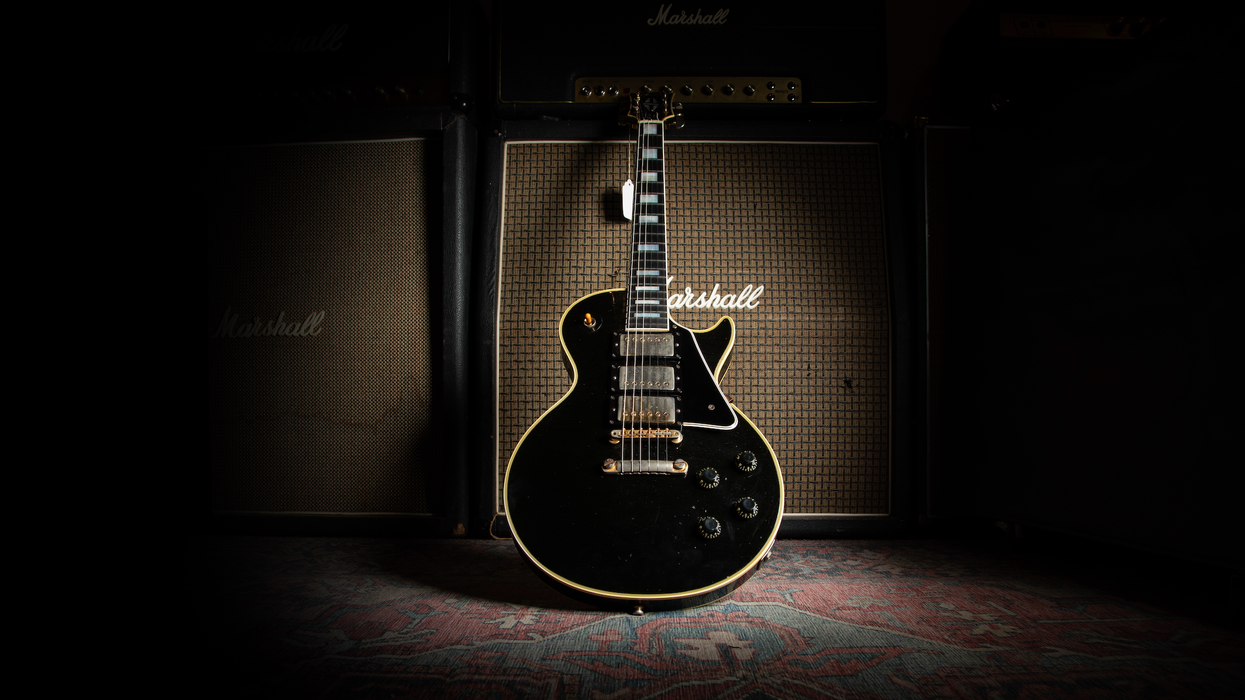
It’s been a minute since we’ve gotten to share something truly special with you all, and today’s subject is one of the finest: a 1959 Gibson Les Paul Custom.
Gibson introduced the first Les Paul Customs in late 1953, following a couple of prototypes built for Les Paul a year earlier. Les wanted what he called a “more elegant” version of the Les Paul Standard, something that looked sharp on the booming new medium of television. His request was specific: a black guitar with refined appointments and design tweaks to match his playing style.
The original Customs carried two pickups: an alnico “staple” single-coil in the neck and a P-90 in the bridge. They featured black finishes, white binding, gold hardware, and the split-diamond headstock inlay we now associate with the model. The headstock was slightly larger than the Standard’s, and the carve at the scarf joint was lengthened for easier play near the nut.
Perhaps the most distinctive feature was the fretwork. Les requested low, wide frets, which led to the nickname the “Fretless Wonder.” While iconic, these frets can feel unusual to modern players. Still, Les’ highly developed technique probably made frets almost unnecessary for him. Another major innovation appeared on the Custom: the debut of the ABR-1 Tune-o-matic bridge, finally giving players accurate intonation adjustment.
Here’s an interesting twist in the Custom’s story. Les’ original vision called for the Standard to be built from solid mahogany with a gold-painted top, and the Custom to use a maple cap on mahogany, finished in black or white. Gibson flipped those specs. The production Standard ended up with a maple cap, while the Custom was built entirely of mahogany.
The all-mahogany build gave the Custom a darker sound, so Gibson used an ebony fretboard to restore some brightness. Meanwhile, the maple-topped Standard was paired with a warmer Brazilian rosewood ’board. Ironically, it wasn’t until 1968 that the Custom attained the maple top Les had wanted all along.
“Instruments like this inspire players across generations.”
The next major leap came in 1957, when Gibson introduced Seth Lover’s groundbreaking humbucking pickups. By mid-year, the Les Paul Custom carried not two but three humbuckers. This gave players a wide tonal palette spanning jazz, pop, country, blues, and eventually rock. In time, artists like Keith Richards and Jimmy Page made unforgettable recordings on Customs, further cementing the model’s place in music history.
That brings us to the stunning 1959 Les Paul Custom currently here at Carter Vintage. I had the chance to spend a morning with it, and it’s easily one of the best-playing guitars in the shop.
Remember my earlier complaint about the “Fretless Wonder” frets? This one has been given a perfect refret by our repair shop. The result is transformative. Suddenly the Custom plays effortlessly, like a hot knife through butter. The setup is dialed in to perfection, and honestly, I walked away a little jealous. It convinced me that a couple of my own guitars need some attention from our techs.
Plugged into a Deluxe Reverb, the guitar absolutely sang. The original PAF pickups deliver remarkable clarity and punch. There’s excellent balance between the bridge and neck, and the middle position, often prone to phase issues, sounds smooth and full-on. Perfect for bluesy bends or country runs.
The neck deserves its own praise. It’s the quintessential ’59 carve: not too big, not too thin, with shoulders that make it feel more manageable than its actual measurements (.89" at the nut, 1.01" at the 12th fret) suggest. Simply put, it’s a neck that disappears in your hands, feeling comfortable, fast, and inspiring.
This particular Custom has been thoughtfully maintained. Aside from the refret and a new nut, the electronics and pickups remain untouched, and the finish is all original and in excellent condition. At about 9.5 pounds, it’s substantial, but its balance makes it feel lighter than the number on the scale suggests.
The Les Paul Custom has always been a guitar steeped in history. Born from Les Paul’s vision, refined by Gibson’s innovations, it was carried into legend by the players who made it sing. This 1959 example embodies all of that and more. With its perfect refret, killer PAFs, and ideal ’59 neck, it’s a joy to play and living proof of why this model continues to hold such a revered place in guitar history.
For me, it wasn’t just another morning with a guitar—it was a reminder of why instruments like this inspire players across generations.
Written with help from Andrew White.
Striking a New Chord

I’ve been writing about music and music gear, in one form or another, for many decades now. I’ve been playing music—writing, recording, performing, for even longer. And I’ve been reading music magazines—specifically guitar magazines—longest of all.
As a child, music magazines were treasure troves of insider knowledge and practical—or, depending on the artist being interviewed, thoroughly dubious—wisdom. They were to be studied, pored over, dog-eared, and piled in messy, corner-of-the-room stacks that eventually got jammed into messier, stuffed-to-the-point-of-exploding cabinets. With guitar magazines, this fascination, and pack-rat behavior, was amplified in every way. It felt like the secrets to an entire universe were unlocked every month. And not just the basics like how to play, what to buy, and what was new. You learned how to write and arrange music, how to change strings, how to repair necks, how to wire pickups, how to modify amps, how to design a signal path, how to establish your own unique sound. How to create.
This creative spirit is what I feel has always set guitar magazines apart, from back in the days when the industry was crammed full of titles and print was the main engine, to now, when it’s even more crucial to give readers something tangible—to entertain, but also to teach. To explore and inspire. To discuss, commiserate (because let’s face it, this world can often be frustrating and challenging), and build community around our shared obsession.
This mindset led me into journalism and has kept me here all these years. And so it’s with tremendous excitement and pride that I join Premier Guitar as your new Editorial Director. I’ve been reading the title since its inception, and over the years have contributed stories on artists I greatly admire—I’ll point to interviews with Thurston Moore and Jim Campilongo as two recent examples. I’ve known our recently retired Editorial Director Ted Drozdowski since I was a managing editor in my first magazine job out of college (trust me—that’s a long time), and I thank him for this incredible opportunity.
I’ve always loved Premier Guitar for delivering quality content from some of the most knowledgeable people in the industry. And it’s not just about putting the stars of the day in every issue—we tell stories from every corner of our musical universe. This issue exemplifies that approach. We celebrate the unsung heroes who keep our industry humming, with a feature on StewMac and Allparts—companies that have revolutionized the DIY guitar universe, and spotlight the often-overlooked guitar techs whose expertise keeps our biggest names sounding their best, night after night.
We also showcase the standard bearers and icons. We sit down with legends like Vernon Reid, a fellow New Yorker whom I had the privilege of interviewing about his new solo album, Hoodoo Telemetry, which finds him gathering sounds and influences from across space and time. We go deep with ascending talents like Daniel Donato, whom I recently watched deliver some incendiary cosmic country with his band, the aptly named Cosmic Country, ripping truly mind-boggling licks on his DGN Custom Epoch semi-hollow under a perfect late-summer evening sky. We dive into experimental territories with Los Angeles metal band Agriculture and their challenging new record The Spiritual Sound, and visit with Winnipeg’s Living Hour to explore their dreamy, noisy soundscapes.
And on our cover, we have Daron Malakian—a figure who straddles both worlds as one of the oddest and most unlikely mainstream rock stars—examining his creative process with both System of a Down and his own project, Scars on Broadway. His approach to songwriting and guitar playing challenges conventional thinking in the best possible way.
But none of these artists outshine our columnists, who month after month provide some of the most insightful commentary in the guitar universe. Their expertise and passion illuminate everything from technique to tone, from vintage gear to cutting-edge technology. They cover everything from oddities to esoterica to recording to performing, drawing from lifetimes of experience.
And then there’s the gear itself—the star of our show. Whether you’re hunting for your next dream guitar, investigating the latest pedal innovations, digging into amplifier design, exploring software and recording technology, or tracking down that one missing link that’ll finally complete your rig, we’re here to guide you through it all.
There’s also exciting news on the horizon. We’re working on a fresh new look and implementing several behind-the-scenes improvements that will enhance your Premier Guitar experience. Stay tuned—good things are coming.
My goal is simple: to continue Premier Guitar’s tradition of being your most trusted guide through this ever-changing landscape. Whether you’re a weekend warrior, a touring professional, or somewhere in between, we’re here to feed your passion, fuel your creativity—and help you seriously geek out on guitars and gear.
Now let’s make some music together.
Martin Guitar Unveils OM Mikael Åkerfeldt Signature Model
Today at Guitar Summit in Mannheim, Germany, C. F. Martin & Co.® unveiled the OM Mikael Åkerfeldt, a limited-edition acoustic created with the Opeth frontman. Only 74 guitars will be made worldwide, honoring the Swedish musician’s 1974 birth year.
The OM Mikael Åkerfeldt blends Martin’s renowned craftsmanship with bold new features. It pairs a torrefied spruce top with a dramatic three-piece back of Guatemalan rosewood and an East Indian rosewood wedge, accented by European flamed maple binding. For the first time in a traditional body, Martin has introduced its Low Profile Velocity neck—designed for our SC models, and ideal for players used to the speed and comfort of an electric.

Personal details include an ebony fingerboard with black mother-of-pearl Roman numerals and black Liquidmetal® bridge pins for added sustain and clarity. Inside, VTS-treated spruce and Golden Era scalloped X-bracing—as featured on the Modern Deluxe Series—deliver vintage warmth and dynamic response.
“Is this the best guitar I’ve ever played? Including the ones in your museum? I believe so,” Mikael said. “It just sings—the resonance, the clarity, the low end. Everything about it feels magnificent.”
Each guitar includes a laser-etched stainless-steel label and custom Harptone case.
ABOUT MIKAEL ÅKERFELDT
Mikael Åkerfeldt is the frontman, guitarist, and primary songwriter of the pioneering progressive metal band Opeth. Since joining in the 1990s, he has led the group from its death metal roots into genre-defying territory, blending guttural growls with clean baritone vocals and weaving progressive rock, folk, and classical influences into its sound. Under his leadership, Opeth has earned two Swedish Grammis awards and established itself as one of Scandinavia’s most influential metal bands.
Mikael's artistry extends well beyond Opeth. He co-founded Storm Corrosion with Steven Wilson, contributed vocals to Bloodbath, and composed the score for the Netflix series Clark. Ranked among the greatest modern metal guitarists, he is also a devoted vinyl collector and music historian with a deep reverence for tradition and craft. His connection to Martin guitars goes back to the early ’90s, when he sold them at a small shop in Stockholm. Decades later, that relationship comes full circle with his own signature Martin—a collaboration that unites elegance, darkness, and uncompromising creativity.
NS Design Unveils New Carbon Fiber Fin Guitar and Bass
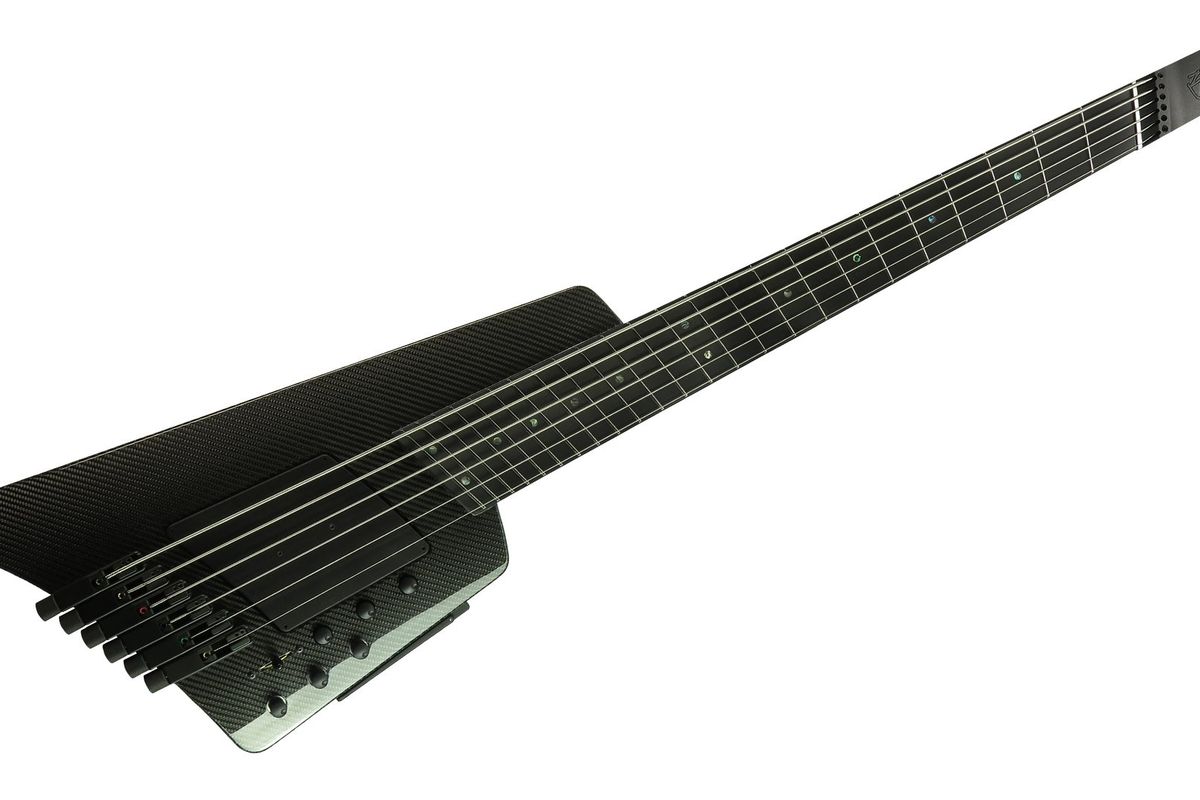
Ned Steinberger, inventor of the headless bass, has unveiled his new NS Design Fin guitar and bass at the Mannheim Guitar Summit in Germany. These multiscale instruments are available in 6-string configurations and combine cutting-edge carbon fiber construction with innovative electronics to deliver unparalleled sonic performance for the modern musician.
Key features of the NS Fin Guitar and Bass include:
- All-carbon fiber construction for extended sustain, brilliant harmonics, and bold low-end response.
- Lightweight ergonomic design - Guitar weighs just 5½ lbs., bass only 8 lbs., with perfect balance.
- Modular pickup configuration allows any combination of humbucking and single-coil pickups.
- Revolutionary Activator™ circuit by Mi-Si™ with supercapacitor power and up to 12dB boost.
- Fulcrum™ tuning system features a patented self-clamping mechanism for quick string changes.
- The scale length ranges for the guitar and bass - Guitar: low E string 26 inches, high E string 25 inches. Bass: low E string 35.3 inches, high C string 32.7 inches.
- Multiscale fretboard provides optimized string tension and intonation for enhanced playability.
NS Design’s Fin Guitar is priced at $8,500 USD, and the Fin Bass is priced at $9,500 USD. They are available in a limited-edition run of 12 each, made in USA from 100% carbon fiber. For more information visit thinkns.com.
PRS SE NF 53 Review
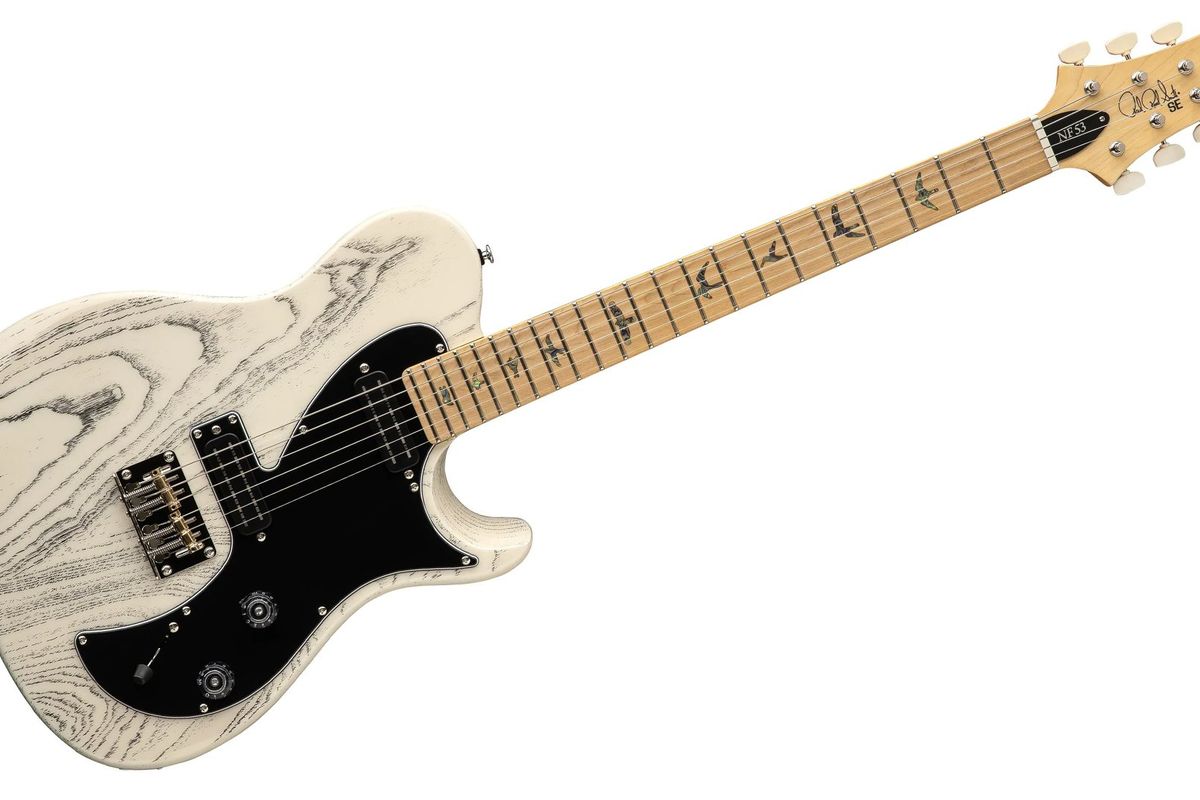
Like the Silver Sky, the NF 53 revealed Paul Reed Smith’s deep reverence for classic Fullerton designs and curiosity about how to expand on those templates. 2023’s NF 53 release left us impressed, and it was only a matter of time until an offshore-built SE model followed. That time has come: The SE NF 53 is here, dressed in the same lines and livery as the USA-built model, but at a more affordable price point thanks to PRS-licensed and supervised manufacturing by the Cor-Tek Musical Instrument Co. in Indonesia.
Like the NF 53, the SE model is more a riff on the Telecaster theme than a copy. Unburdened by tradition, PRS carved away at every line of the single-cutaway form, and the electronics are very much about enhancing versatility, rather than reducing componentry to the absolute basics. Even so, the SE NF 53 still drips with Tele-ness.
Single-Cut Minded
T-style traditionalists will find much that feels familiar, like the 25.5" scale length and bolt-on maple neck. From there, though, the SE NF 53 deviates from vintage T-style spec pretty quickly. There are 22 medium-jumbo frets, and the neck is constructed with a scarf joint that increases strength at the headstock break. The maple fretboard is sliced away from the neck and reglued after installation of the truss rod. Its width at the nut falls between Gibson and Fender camps at 1 41/64". The 10" radius also splits the difference between vintage Gibson and Fender specs, and it all feels great in hand courtesy of a rounded-C profile that measures about .87" deep at the first fret. The guitar’s overall weight is around 8.1 lbs.
In Telecaster style, the SE NF 53’s body is made from swamp ash—in this case, using 3-piece construction. It features belly and forearm contours, and a contoured cutaway for easier upper-fret access. PRS maximized the drama of the ash’s distinctive grain with a white doghair finish on our review sample, and black grain filler makes the wide, rippling lines pop and weave beneath the white. They reverse the effect entirely on the black doghair version, and hide the grain entirely on the pearl white finish.
In the hardware department, the SE NF 53’s bridge nods to a vintage Telecaster’s brass barrel saddles, but it uses a steel-base design with string-anchor notches rather than through-body stringing. It also deviates from T-style tradition by assigning three strings to a saddle with two adjustment bolts, rather than three saddles with two strings each.
Like the USA model before it, the SE NF 53 is fitted with a pair of PRS’s Narrowfield DD pickups, although these are the “S” variant, which are designed to enhance low-end tones while retaining snarl and twang. The “DD” stands for deep dish, meaning these single-coil-sized humbuckers are made with deep bobbins to enable extra coil windings, using a mix of magnet pole pieces with steel poles in between. They are wired through master volume and tone controls and a three-way selector switch on a plate that nods toward the late ’60s Fender Telecaster Thinline.
Taken together, the SE NF 53 is a cohesive design, made stronger by its robust build quality. There’s no real lack of refinement in evidence when compared to the USA model. Some of the woods and components are a different grade, but the overall result is a guitar that lends a sense of confidence.
Field Day
Plugged into a Fender Bassman head and 2x12 cab, a Vox AC15 1x12 combo, and a Fractal FM9 into headphones, the guitar reveals a genuine alternative to the T-style formula suggested by its components. Its character is distinctly its own—and with noticeably less hum.
The Narrowfield DD “S” pickups play a big part in the guitar’s success. The easiest reference point I can think of might be a blend of Telecaster and P-90 tonalities, but with plenty of their own thing going on. With a clean amp or setting there’s a meaty growl on top of the twang. Yet the guitar isn’t short on bright, sparkly chime, and sounds alive in those frequencies without being strident or spikey. This sonic foundation puts edge-of-breakup tones right in the SE NF 53’s wheelhouse, where the chewy bite segues into a little bit of breakup when you hit it hard. And it’s just as comfortable with high-gain tones, where the same sonic characteristics that contribute sweetness in cleaner settings enable clarity and cutting power while avoiding harshness in the highs. In fact, the guitar is at home in so many settings, sharing a Telecaster’s versatility and its effortless ability to handle almost anything with style.
The Verdict
The NF 53 platform is a very likeable tribute to the seminal T-style without trying to replicate it and, as a result, it’s versatile and inspiring guitar in its own right and in its way. And in the SE version of this design it delivers at a price that belies its vocabulary and its confidence.
Pedalmania! Keeley, Mr. Black, Hotone, and NUX Demos
As the leaves change and the holiday season approaches, PG contributor Tom Butwin highlights standout pedals from the bevy of tone machines that graced shelves this year. In his first installment of Pedalmania, hear demos of the flexible Keeley Manis Overdrive, Mr. Black's DoubleTracker Stereo, the spacey new Hotone Verbera convolution reverb, and the featured-packed NUX Amp Academy Stomp.
Remembering Tony Rice: 8 Iconic Licks from the Master Guitarist

In December of last year, Tony Rice passed away. He was/is my all-time favorite guitarist. Like many of his fans, my love of his playing has likely transcended obsession. In fact, at the time of writing this, I have transcribed over 100 Tony Rice solos. That puts me in a unique position to share with you not only my favorite Tony Rice licks but what I think might be Rice's favorite licks, if the frequency with which he played them is any indication.
These examples can be found in almost every Tony Rice break. They are integral to his sound and they can become part of your sound too. This comes with one small warning though: These licks are not meant to be parroted off this page. A big hallmark of this sound is to use these phrases but to vary them, and create your own versions of them. Let's remember Rice by innovating on his past achievements the same way he innovated on the achievements of the players that came before him.
How to End a Bluegrass Song
One of the most famous and enduring Tony Rice licks is this signature tag. A tag is a common way to end a bluegrass fiddle tune or vocal song, the most generic tag being the ubiquitous "shave and a haircut." In Ex.1, you can see what's called a "double" tag. The first tag ends on beat 3 of measure two, before the open 3rd string on beat 3. The remainder of the lick forms the second tag, which eventually morphs into a variation of the Lester Flatt "G run."
Rice's note choice is predominantly major pentatonic but includes an occasional b3 that always resolve down to the 2 or up to the 3. As I say to my students, "Blue notes need buddies." Playing these pairs of notes with articulations like slides and pull-offs that cross bar lines is an important part of Rice's style.
Tony Rice Ex. 1
Use Your Chords
If you're familiar with triads on the D, G, and B strings, you can turn those into bluegrass licks as well. Rice has used the triads in Ex. 2 in a handful of different and interesting ways. He's used the last two chord shapes to form the main riff for "Me and My Guitar," and employed those same shapes to punctuate the end of his "Cold on the Shoulder" kick-off. Sometimes you can see him expand this idea by using even more chord shapes to descend the neck. He would use something like Ex. 2 in a G major context but would be heavily implying G Mixolydian mode by using the F major and D minor triads.
Tony Rice Ex. 2
That One Lick
I've seen this passage referred to multiple times as "that one Tony Rice lick." He uses variations of this passage to finish breaks in "Your Love Is Like a Flower," "Ain't Nobody Gonna Miss Me When I'm Gone," and "Gold Rush." It serves the function of a statement piece to assert his personal voice on the instrument before handing off the spotlight to the next instrumental break or verse of a song with vocals.
As you play Ex. 3 be mindful of how you use your pinky. Every note on the 10th fret is played with the pinky, including a brief pinky barre on the 10th fret of the 3rd and 4th strings.
Tony Rice Ex. 3
Pull-Off Central
This lick has been featured in recordings, but I associate it much more with Rice's live sound. Whenever Rice needs a second to think about what to play next, Ex. 4 seems to come to his fingers first. The note choice here lands firmly in the minor pentatonic camp but he manages to create a little bit of an outside sound with the third iteration of the pattern that brings in the b5 at the 6th fret of the G string.
Tony Rice Ex. 4
Escape Notes
Have you ever been stuck up the neck improvising with no idea how to get back down to something more familiar? Me too! So, let me introduce you to escape notes. Sometimes you can find an open string that will continue your line in a linear fashion while freeing up your hand to shift down the neck. Take a look at the F, E, and D eighth-notes in the first measure of Ex. 5. Rather than playing those three notes in position, Rice is using the open 1st string so he has time to shift his hand while continuing his eighth-note line.
There are examples of Rice using variations of licks like this in "Blue Railroad Train," "A Hundred Years from Now," and "Likes of Me." You can use this in a D major context or in a G major context over a D chord.
Tony Rice Ex. 5
Acoustic Bends
It can be done, and in a situation like this we're not necessarily shooting for something perfectly in tune. In Ex. 6 you can see that pulling down on the 4th string at the 3rd fret will bring the note closer to F#, the 3 of the chord, but in practice Rice usually doesn't get all the way there.
Tony Rice Ex. 6
Phrasing
If you asked a random flatpicker at a bluegrass festival to play a Tony Rice lick, they would probably play something like Ex. 7. These types of phrases have endless variations and demonstrate Rice's long-standing influence on bluegrass music. These licks are built from a G minor pentatonic (G–Bb–C–D–F) bone structure but always feature a pull-off from the 2nd fret to the 1st fret on the B string and a slide from 3rd to 4th fret on the G string. This pull-off and slide are great reminders that blue notes need buddies.
Tony Rice Ex. 7
True Minor
Bluegrass isn't all major tunes though. There are standards in minor keys. We're talking about tunes that are actually minor—not just playing minor pentatonic licks over major chords. With that in mind, it would be wrong of me to not mention Ex. 8, one of Rice's favorite improvisational ideas to employ over minor tunes. This kind of lick is all over Rice's original compositions in minor keys and the recordings he made with David Grisman. The idea is framed in a slightly ambiguous way, so you can find Rice using it in A minor and D minor.
Tony Rice Ex. 8
It's an impossible task to completely distill Tony Rice's playing into a single lesson. I would point you to nearly any album in his discography to get the essence of modern bluegrass guitar right from the source. His touch, feel, tone, and vibe forever changed acoustic music and we all will be eternally grateful.
Essential Tony Rice Videos
Tony Rice liked to perform "Me and My Guitar" with an extended jam in the middle. Many licks from this lesson appear in his guitar break at 6:00.
Tony Rice's "Church Street Blues"
There's very little footage of Tony Rice performing his iconic interpretation of Norman Blake's "Church Street Blues." This arrangement may be one of the most difficult to replicate from Rice's catalogue.
Tony Rice's "Old Home Place"
Tony Rice performs on the definitive recordings of multiple bluegrass standards but "Old Home Place" may be the most important. JD Crowe & The New South's self-titled release is considered by many to be a near perfect bluegrass record.
Tony Rice "Shenandoah"
Most folks talk about Tony Rice's hot-style playing but his melodic chord melody approach to guitar is equally impressive. I doubt we'll ever see an accurate transcription or performance of this era of Tony Rice.
Aluminati Guitar Company Introduces the Floodcaster
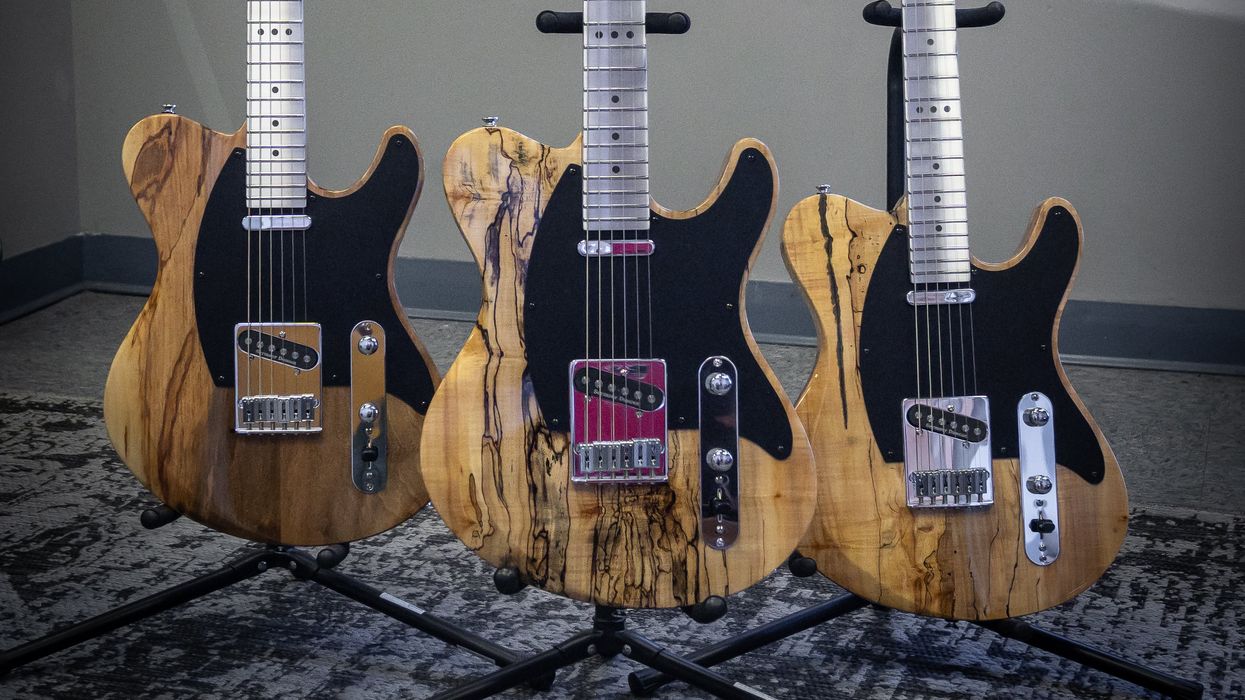
Aluminati Guitar Company, a pioneer in sustainable guitar manufacturing, is proud to unveil the Floodcaster— a guitar with a story to tell. Built from wood reclaimed from the aftermath of Hurricane Helene’s catastrophic flooding in Asheville, these instruments blend history, innovation, and sustainability in a way never before seen in the industry.
When floodwaters surged through Asheville, homes, businesses, and studios were left devastated. Seeking to give new purpose to damaged materials, Aluminati salvaged enough reclaimed wood for a charitable run of guitars. Paired with Aluminati’s precision-engineered aluminum necks, the Floodcaster is a guitar that not only delivers exceptional performance but also tells the story of Asheville’s resilient community.
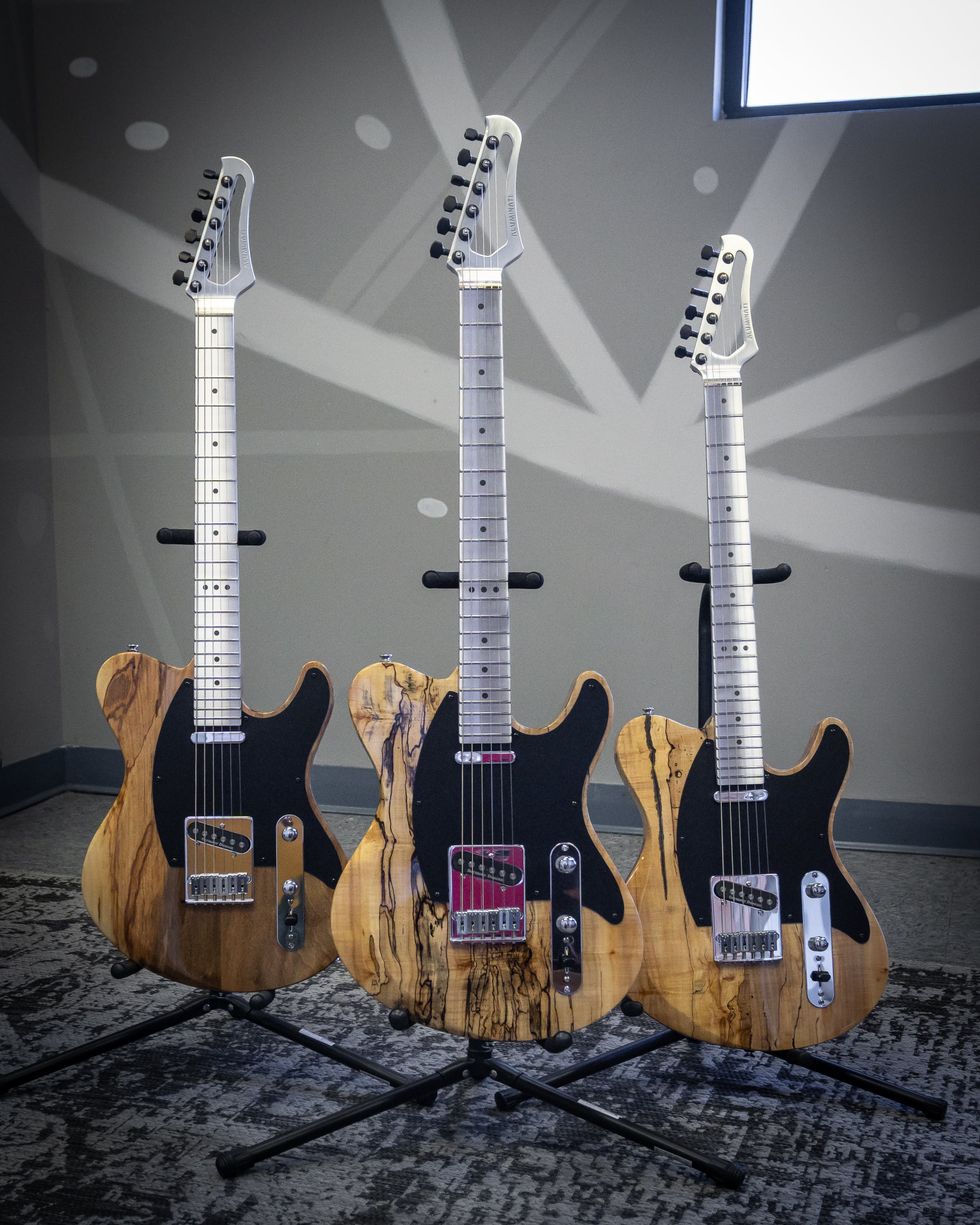
“Every piece of wood used in the Floodcaster Model has a story, and we’re turning that story into an instrument that players will cherish,” says Aluminati CEO, James Little.
Featuring unmatched sustain, clarity, and durability, the Floodcaster is built for modern players who value both performance and craftsmanship. With reclaimed materials giving each guitar a distinctive character, no two Floodcasters are exactly alike.
Giving Back to WNC
A portion of the proceeds from each Floodcaster sold will go directly to relief efforts in Western North Carolina, supporting communities still recovering from the devastation of Hurricane Helene. By putting these materials back to work, Aluminati is not only creating exceptional instruments but also helping rebuild what was lost.
After the initial release, Aluminati plans to partner with high-profile guitarists who will play and sign a select number of Floodcasters. These one-of-a-kind instruments will be sold at auction, with a portion of proceeds going directly to WNC relief efforts.
The first run of Aluminati Floodcasters will be available for purchase at $6,999 on Aluminati’s website, September 27th, 2025.
Floodcaster Specs:
- Aluminati HollowCore™ Aluminum Neck
- Aluminum Fretboard
- Sperzel Locking Tuners
- Jescar Jumbo Stainless Steel Frets
- Bolt-on Brass Nut
- Seymour Duncan ¼ Pounder Tele Pickups
- 3-way Toggle with a reverse control plate for volume swells.
- Gotoh Modern Tele Bridge
- Reclaimed Spalted Maple Body
- 25.5” Scale with 22 Frets
- 12” Radius
- D Shape neck
- Hand Wired and Finished
- 250k Bourne Pots
EarthQuaker Devices Announces the Barrows Fuzz Attacker
Barrows pays homage to the iconic MKII circuit while adding modern refinements that would make even the most discerning vintage purist weep tears of harmonic joy. At its heart, Barrows features a trio of carefully matched germanium transistors nestled within finely tuned circuitry that has been lovingly coaxed to produce everything from light, singing distortion to crushing fuzz tones with nearly infinite harmonic-rich sustain.
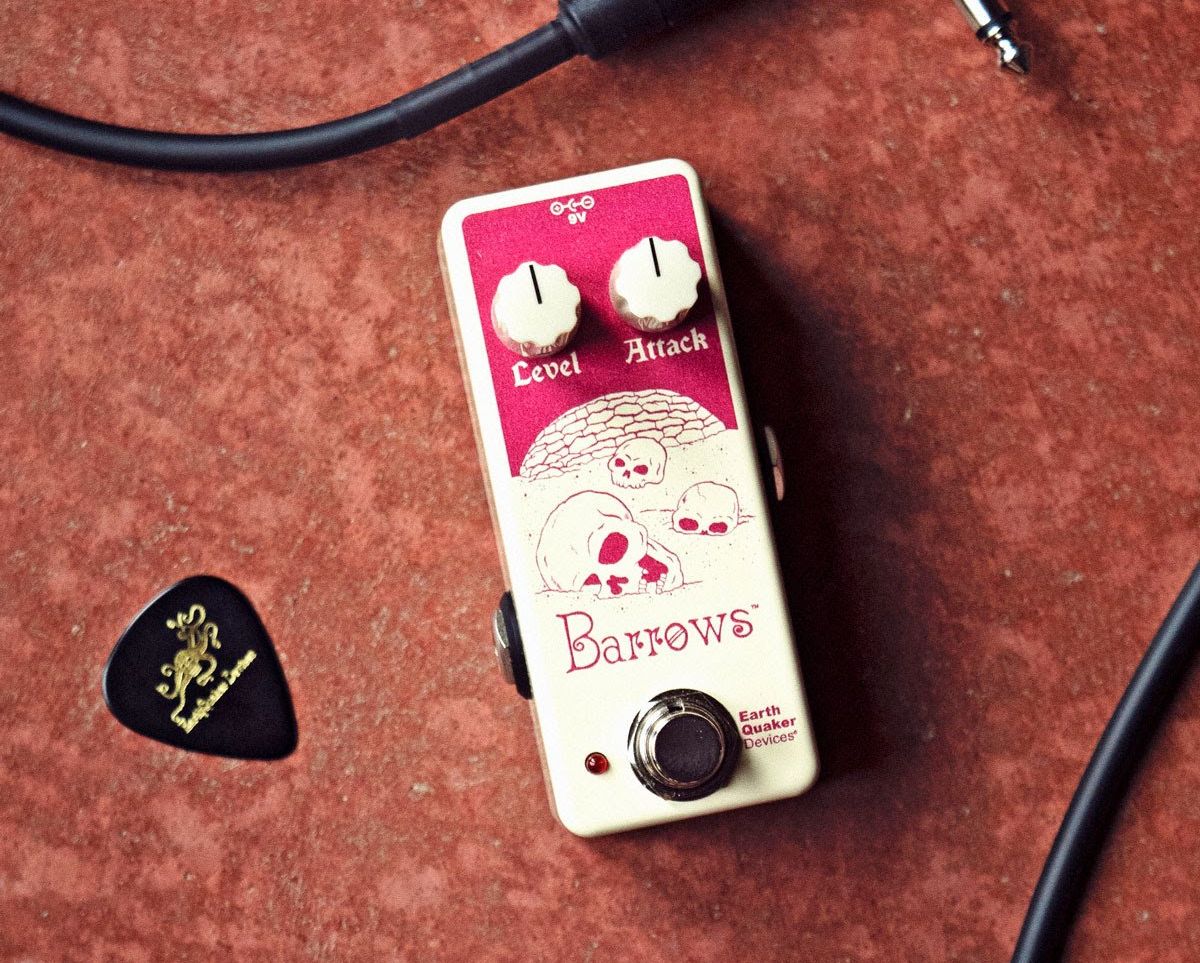
The original MKII circuit was the secret weapon behind some of the most crushing riffs ever committed to tape. From dawn-of-metal caveman dirges to the wall-of-sound symphonies conjured by the highest tiers of shoegaze sorcerers, this legendary topology has been the foundation of countless sonic monuments. Now, with Barrows, you can channel that same lightning-in-a-bottle magic while enjoying the reliability and versatility that modern craftsmanship provides.
At its heart, Barrows features a trio of carefully matched germanium transistors nestled within finely tuned circuitry that has been lovingly coaxed to produce everything from light, singing distortion to crushing fuzz tones with nearly infinite harmonic-rich sustain. This isn’t just another fuzz box – it’s a portal to the fabled tones that have haunted the dreams of fuzz fanatics for decades.
Barrows delivers the signature cutting mid-focused tones with plenty of low-end authority and brilliant top-end grind that made the original MKII a studio legend. But unlike its temperamental ancestors, Barrows includes several modern upgrades that transform it from a vintage curiosity into a contemporary powerhouse.
The phase-corrected and buffered output ensures it plays nice with other pedals down the line, while the increased output volume and wide range of fuzz tones make it a versatile sonic weapon. All this power is packed into a compact footprint that saves precious real estate on your pedalboard, because every square inch matters when you’re building your sonic arsenal.
Gone are the days of finicky positive ground power requirements and battery-only operation. Barrows runs on standard 9V power supplies, making it compatible with any common pedalboard power source. The true bypass switching ensures your signal remains pristine when the pedal is disengaged, while the MKII circuit works its germanium magic when called upon.
Each Barrows is lovingly assembled by shrimply the best helmspeople (and one obedient robot) on the high seas of Akron, Ohio, USA.
Tech Specs:
- Vintage three-transistor germanium fuzz circuit that is based on the Tone Bender MkII.
- Cutting, mid-range focused tones with loads of sustain and volume.
- Very responsive to playing dynamics and guitar volume control.
- Small form factor will fit on even the most cramped pedal boards.
- Mechanical true bypass switching
- Current Draw: 10 ma
- Input Impedance: 50 kΩ
- Output Impedance: <10 kΩ
- Limited lifetime warranty
- Retail Price: $129.00
BOSS Announces XS-100 and XS-1 Poly Shifter Pedals
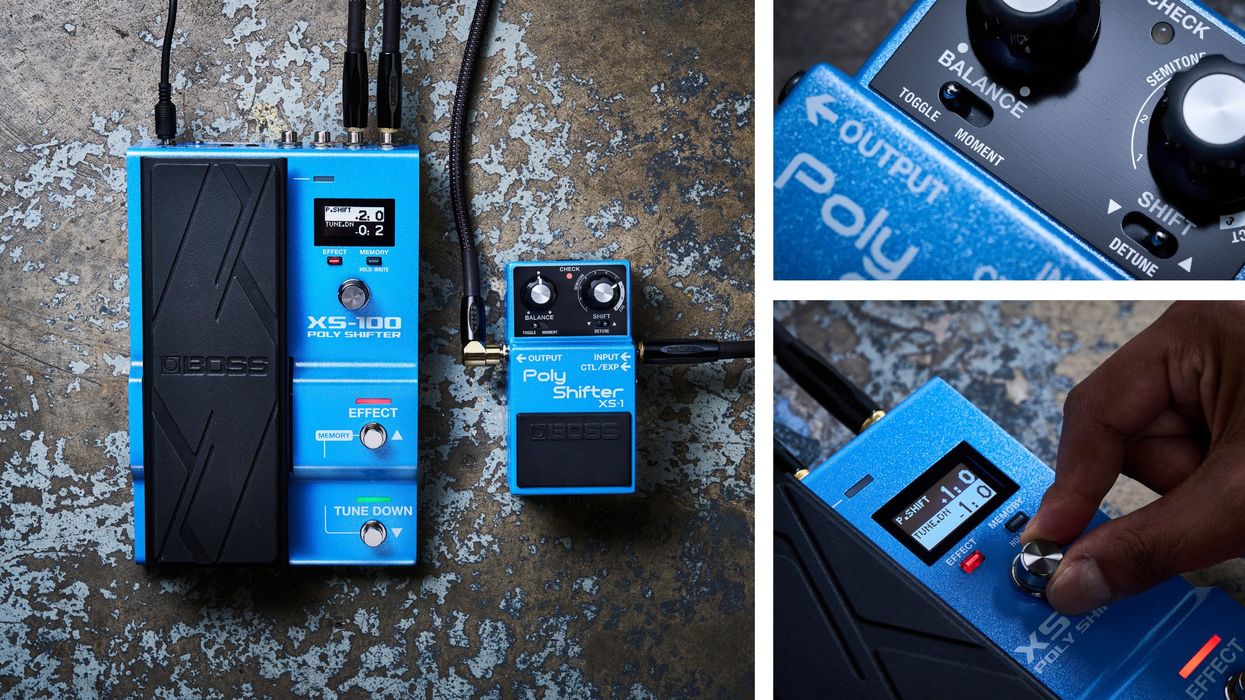
BOSS announces the XS-100 and XS-1 Poly Shifter products, two advanced pitch-shifting effects for guitar, bass, and other instruments. The XS-100 is a pitch-shifting workstation with a massive eight-octave range, real-time pitch control via an onboard pedal and footswitches, and versatile connectivity to interface with other gear. The XS-1 distills the core XS-100 features into the famous BOSS compact pedal format, providing instant drop tunings, capo simulations, octave effects, and linear pitch control with an optional expression pedal.
In developing the XS series, BOSS engineers pioneered new methods to advance real-time pitch shifting and eliminate the tonal artifacts common in conventional designs. Powered by finely tuned algorithms and a specially selected DSP platform, the XS series provides balanced polyphonic performance that feels natural and musical across all playing styles, pickup positions, and pedal setups. The attack and tonal character are fully preserved, and even complex chords and sustained lead tones—typically a challenge for pitch shifters—are reproduced with stunning clarity.
XS-100 Poly Shifter
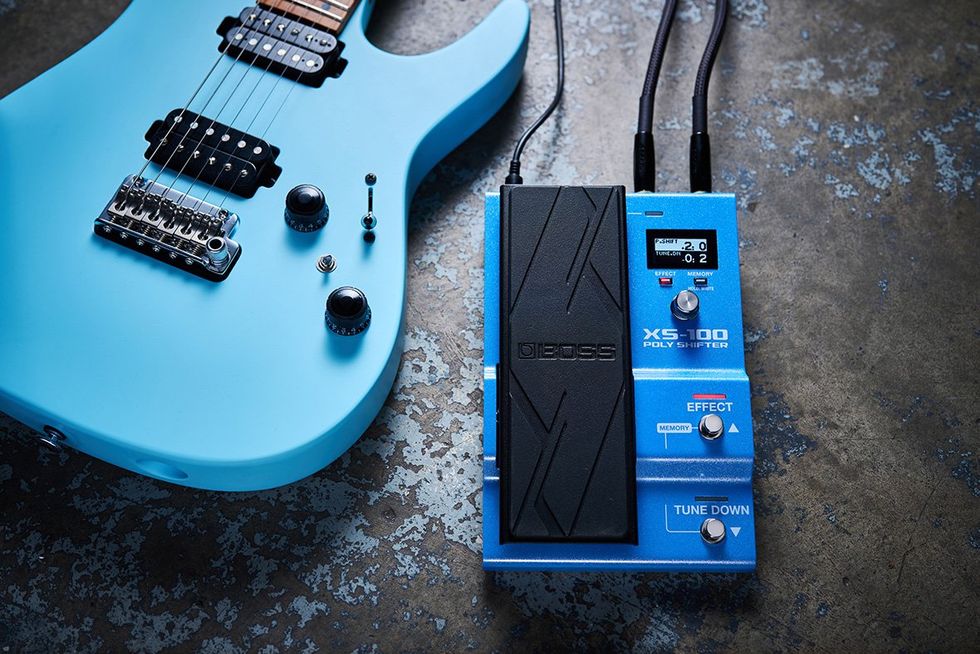
The XS-100 is a powerhouse expression machine that will transform how guitarists and bassists perform with pitch. An onboard pedal provides linear control of four octaves up or down, and independent pitch-change speeds for each pedal direction enable motor revving tones and other interesting effects. At the end of the pedal’s travel, an integrated toe switch can introduce momentary pitch jumps with adjustable range and rise/fall time. Two footswitches are also available to bypass the pedal shift and quickly retune an instrument at fixed semitone steps across eight octaves.
XS-100 users can customize the pedal’s range for different songs or techniques and fine-tune the response curve to suit different playing styles. In addition, the toe switch and footswitches can be reassigned to alternate functions. With 30 onboard memories, players can instantly recall favorite setups during live sets or studio sessions.
The XS-100 supports up to two external footswitches or an expression pedal, expanding the real-time control options. MIDI I/O opens the door to more advanced applications, from external MIDI control to sending MIDI commands with the pedal and footswitches. A secondary output mirrors the input signal, providing parallel routing flexibility for sophisticated rigs.
XS-1 Poly Shifter
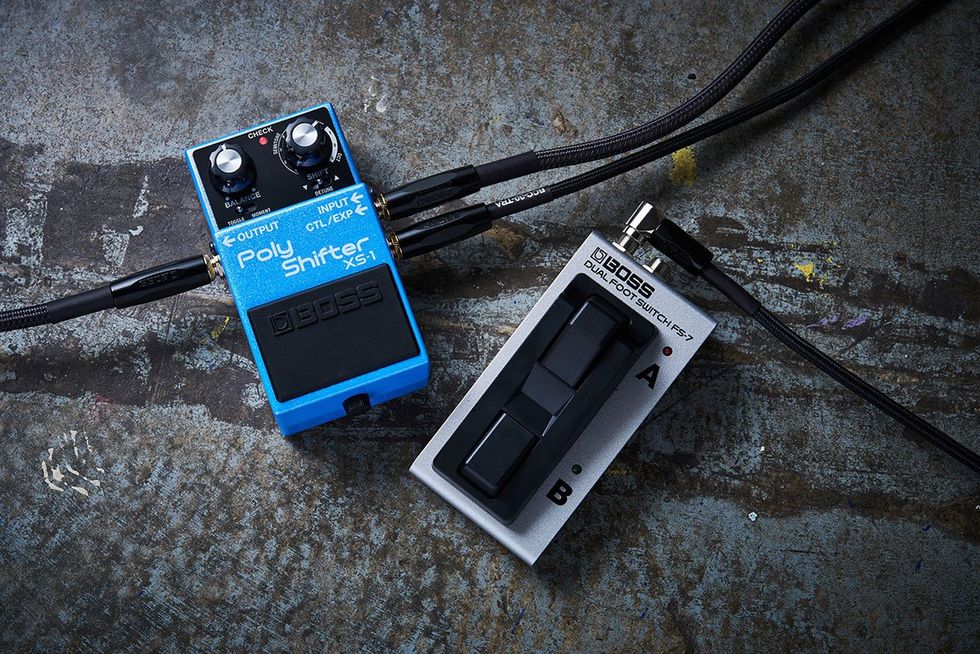
The XS-1 Poly Shifter delivers instant retuning in a convenient pedalboard-friendly footprint, making tuning changes fast, fluid, and seamless. Users can authentically perform songs in drop tunings, change keys to suit a vocalist’s range, play with unique octave-shifted sounds, and more.
Offering a range of +/- seven semitones and three octaves up or down, the XS-1 adapts to virtually any musical need. The intuitive interface features a dedicated Balance knob for adjusting the mix between the direct and effect sound. Turning the knob to effect-only allows for full retuning, while blending in the direct sound can create 12-string effects, parallel guitar/bass sounds, and unexplored sonic colors. There’s also a Detune mode to produce evocative doubling effects with high-definition tone.
The XS-1 provides many control options for different applications. The pedal switch can be assigned for standard on/off or momentary operation, and up to two external footswitches can be connected for fast access to alternate tuning modes with the user’s preferred Balance settings. Alternatively, an external expression pedal can be used to create dynamic pitch-bending effects for dramatic, ear-turning shifts.
Availability & Pricing
The BOSS XS-100 and XS-1 will be available in October 2025 for $349.99 and $199.99, respectively.
For the full press kit (available in several languages), including hi-res images, specs, and more, click here.
To learn more about the XS-100 and XS-1 Poly Shifter pedals, visit www.boss.info.
*USD Price at the time of publishing.
Darkglass Electronics Launches “Entropia”
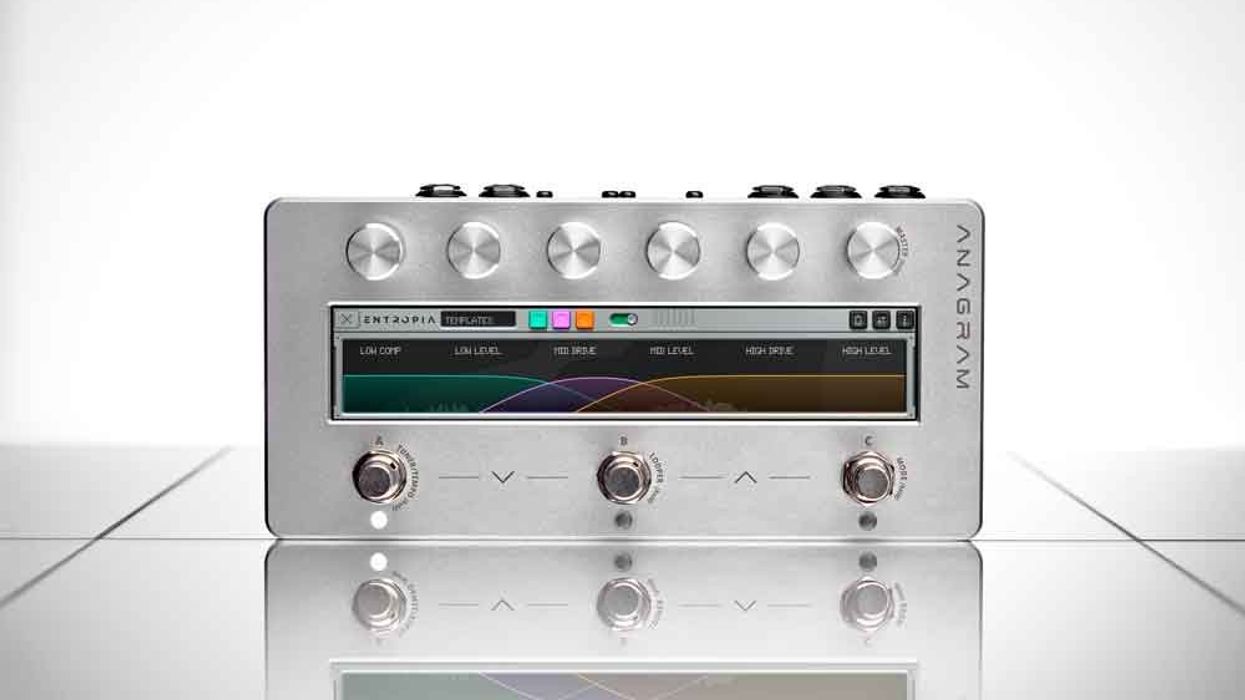
Darkglass Electronics, a global leader in high-end bass amplification and effects, proudly announces the release of Entropia, a groundbreaking multiband compression and distortion plugin designed exclusively for the Anagram platform.
Inspired by the concept of entropy, the natural progression from order to disorder, Entropia empowers musicians and producers to deconstruct and reshape sound with surgical precision. Featuring three fully independent bands (low, mid, and high), Entropia offers unparalleled control over tone sculpting, enabling users to bend, break, and rebuild their sonic landscape.
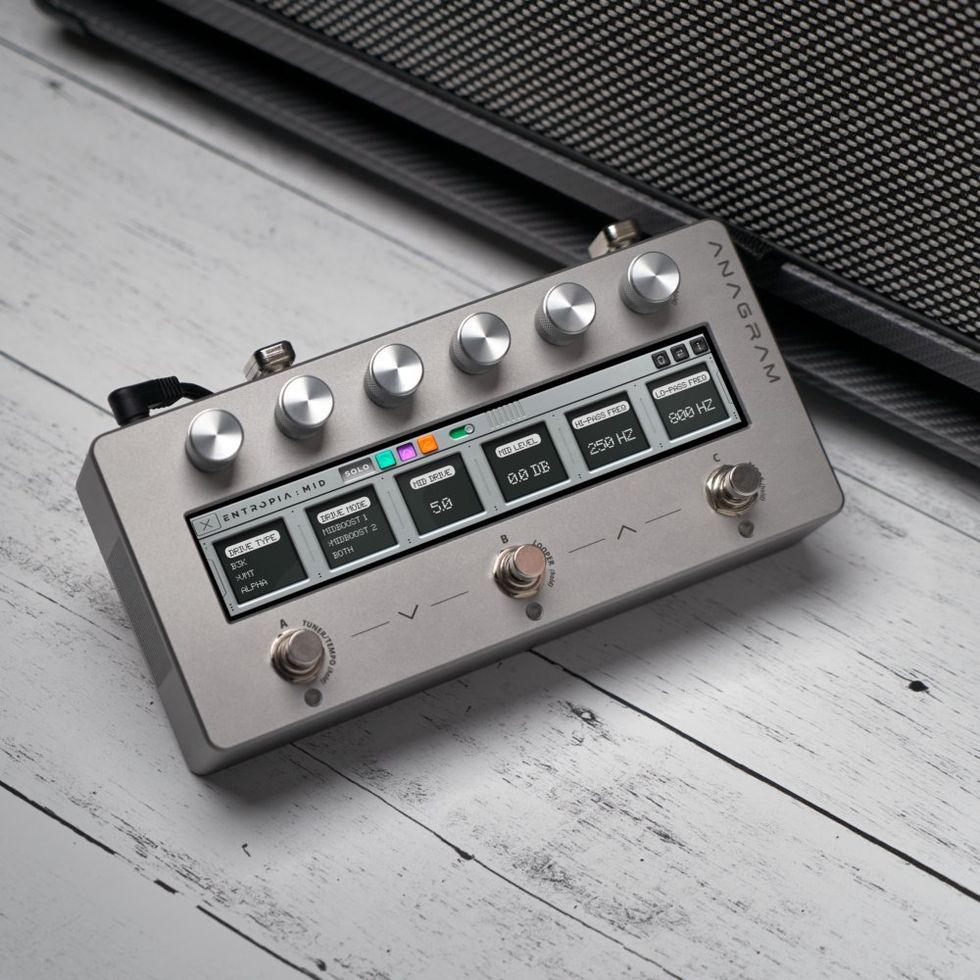
“With Entropia, we open a new door,” said Marcos Barilatti, Director Manager at Darkglass Electronics. “This plugin marks a pivotal step toward a new generation of modular tools for the Anagram platform. It expands the creative possibilities of what Anagram can achieve.”
Entropia introduces a powerful new feature called Templates, expertly curated presets that serve as intuitive starting points for tone creation. These templates allow users to explore the plugin’s full potential with ease, making it accessible to both seasoned professionals and curious newcomers. Unlike traditional distortion plugins that overwhelm the signal, Entropia offers a refined approach to sonic chaos. It’s not just compression and distortion, it’s the artful distribution of entropy, giving users the ability to shape sound with intention and clarity.
Availability
Entropia will be available for download via the Darkglass Suite app starting September 25, 2025. Please note: Anagram pedals will not update automatically. To install Entropia, users must connect their pedal to the desktop Suite and manually initiate the update.
For more information on Entropia please visit www.darkglass.com
DOD Unleashes the Overdrive Preamp 250-X – A New Chapter in a Legendary Pedal’s Story
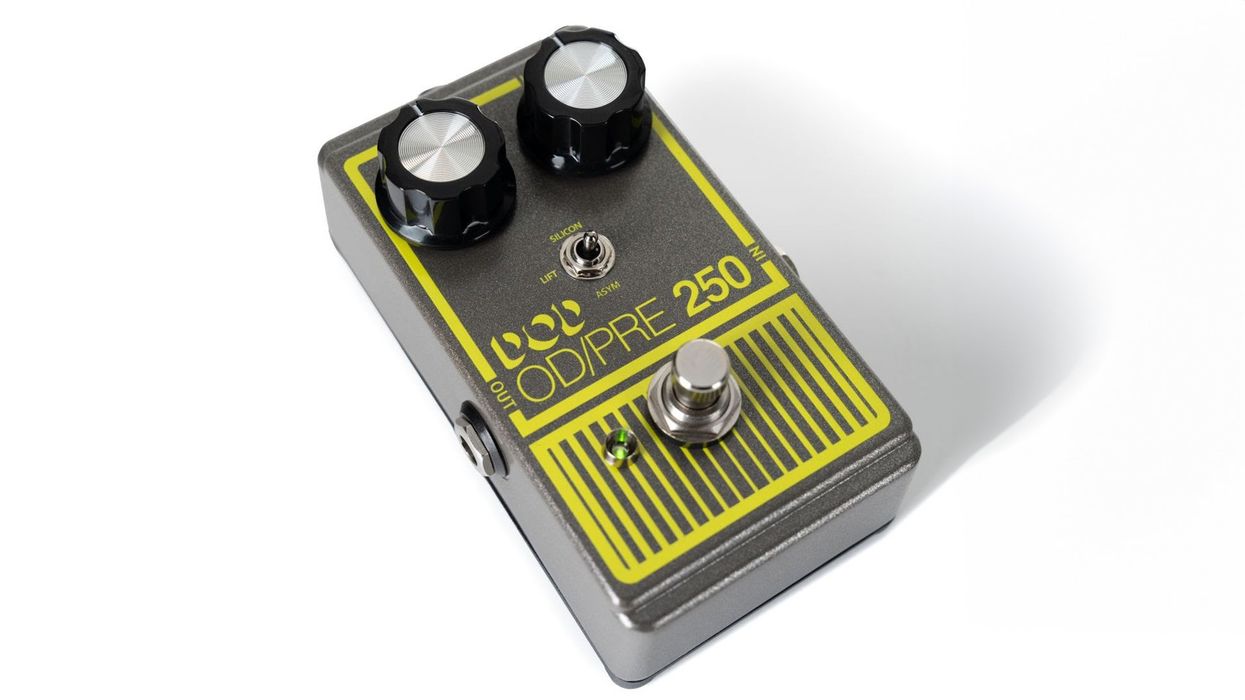
DOD today announces the release of the Overdrive Preamp 250-X, the 10th iteration of its legendary OD250 pedal. Available worldwide through local and online retailers, the 250-X delivers unmatched tonal versatility for players of all skill levels and musical styles. With three distinct distortion modes and modern refinements, the 250-X offers a fresh take on their time-tested classic at a new price point that strives to outperform its contemporaries in its category.
Inspired by the limited-edition DOD OD250-50th Anniversary model released last year, the 250-X (X representing the 10th iteration) offers the same three-position toggle switch function but in an imported, mass-produced model, at a more affordable price.
Operation is straightforward and intuitive. At its core, the 250-X retains the same Gain and Level control values and tapers as the original OD250, preserving the familiar feeling and response that players know and love. The three-position toggle switch expands its tonal range, offers Silicon symmetrical clipping for that iconic 250 sound, ASYM asymmetrical clipping for even-harmonic distortion, and LIFT mode, which removes diode clipping entirely from the signal path for a clean boost at moderate levels or a dirty boost at high levels as it drives the vintage-style LM741 op amp.
Built with an aluminum chassis and weighing in at only 8 ounces (250 grams), construction features true hard-wire bypass, modern 9V DC power input, and +18V tolerant circuitry. With ¼” connections for input and output, the pedal is ready for both stage and studio use making it the most versatile 250 to date.
For more information on the DOD Overdrive Preamp 250-X, visit www.digitech.com.
STREET: $119.99 USD
Rhpf Electronics Introduces The Twin Peaks Eiger-Mönch
Two purpose-voiced delay lines that can run in parallel or interact in a true cascade. Built to transform delay from a passing effect to a core element, shaping time, sculpting space, and unlocking textures never heard before.
RhPf Electronics has introduced the Twin Peaks Eiger-Mönch, a dual-delay pedal that reimagines how guitarists use time-based effects. No tap-tempo divisions or glitch tricks; instead, two distinct voices interact in musical and inspiring ways. One line is bright and articulate, the other warm and lush. Each has its own Rate and Repeats controls so players can shape complementary echoes that blend or collide.
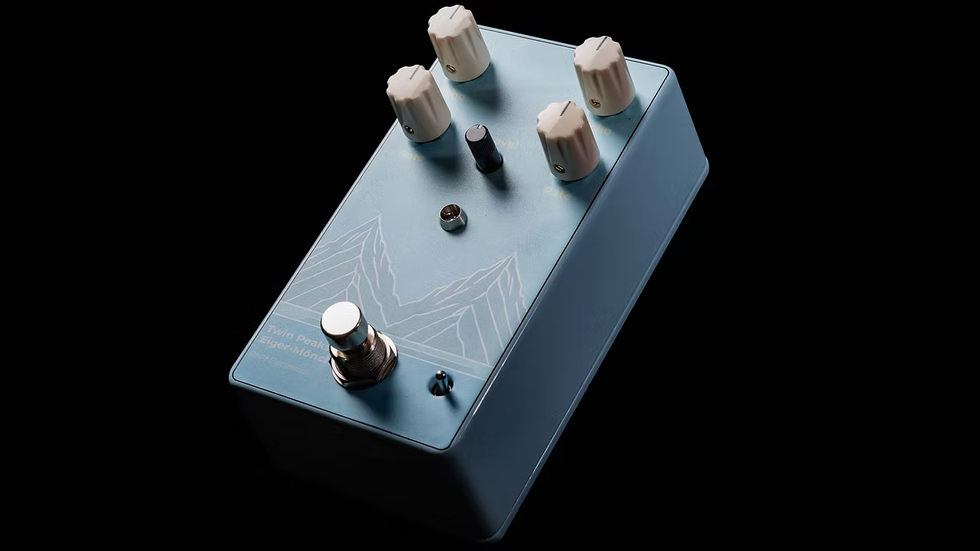
Twin Peaks Eiger-Mönch highlights include:
- Two distinct voices: warm and lush, plus bright and articulate. Each with independent Rate and Repeats.
- Parallel mode: wide, layered echoes that stay open and defined; stereo-like depth from a mono rig.
- Cascade mode: true cross-feedback so each line feeds the other; repeats intertwine and evolve into living textures.
- Designed to stay on: from subtle ambience and slapback to dub-style syncopation, always mix friendly.
- Musical feedback range: carefully tuned to avoid runaway oscillation and gimmicks.
Like every RhPf pedal, Twin Peaks Eiger-Mönch is not a clone, a mod, or a tweak. It is an original circuit designed from the ground up to be a constant companion that can become part of a player’s signature sound.
The Twin Peaks Eiger-Mönch carries a street price of $190 and is available now at select retailers and directly from RhPf Electronics.
The Who Rig Rundown
The Who need no introduction, so let’s get to the good stuff: PG’s John Bohlinger caught up with the band’s farewell tour at Fenway Park in Boston, where guitarist Pete Townshend’s tech Simon Law and bassist Jon Button’s tech Joel Ashton gave him a look at the gear that the infamous British rockers are trusting for their goodbye gigs celebrating 60-plus years together.
Brought to you by D’Addario.
Townshend’s Most Trusted
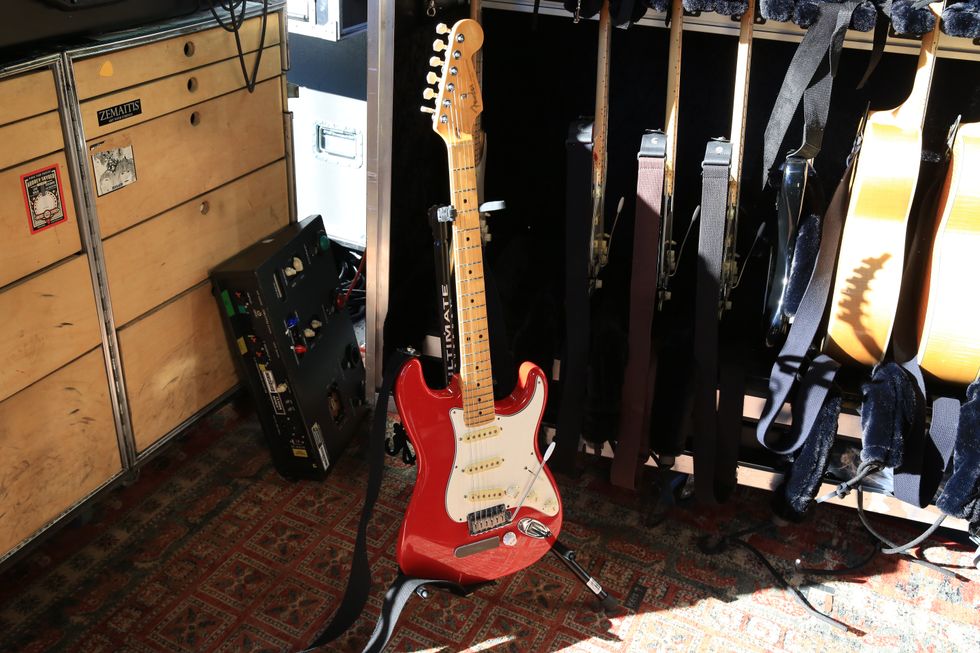
This is Townshend’s No. 1 on this end-days run. Originally an Eric Clapton Signature Stratocaster (the identifying headstock stamp has been scraped off), Law says the body and neck have been changed 10 times, and bigger frets installed. Townshend’s preferred settings are marked on the guitar and knobs.
Other mods include a Piezo bridge with a separate volume control, a stereo socket output, and a blend to mix Piezo signal with the pickups, which are Fender Noiseless models. It also has locking tuners and the Clapton mid-boost circuit, but perhaps most interesting of all is a small piece of emory board glued behind the bridge, utilized by Townshend to rough up the edges of his picks.
Stepped-Down Strat
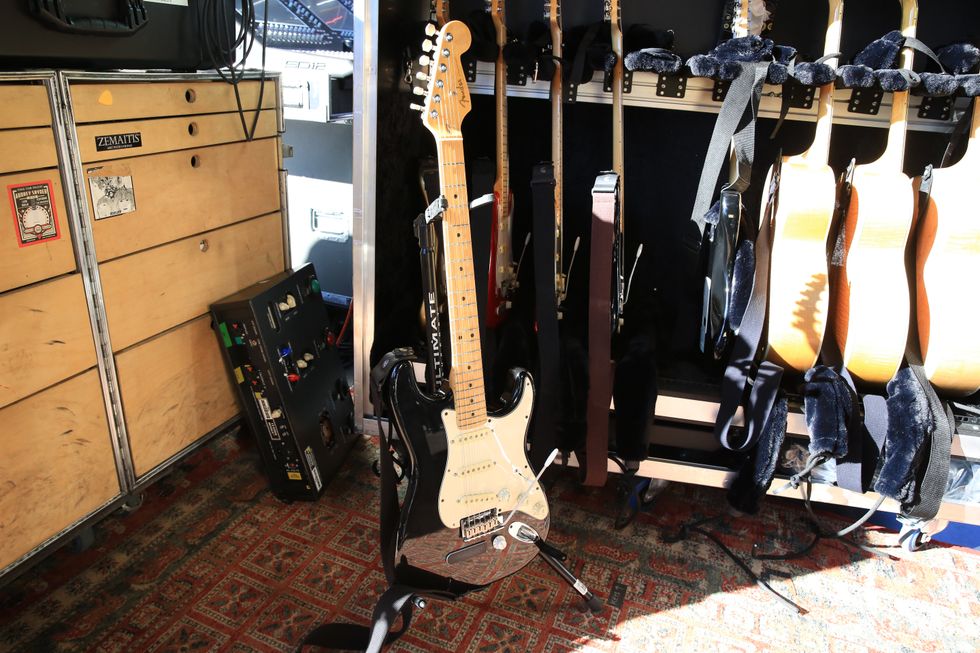
This black Strat comes out for songs in E-flat tuning.
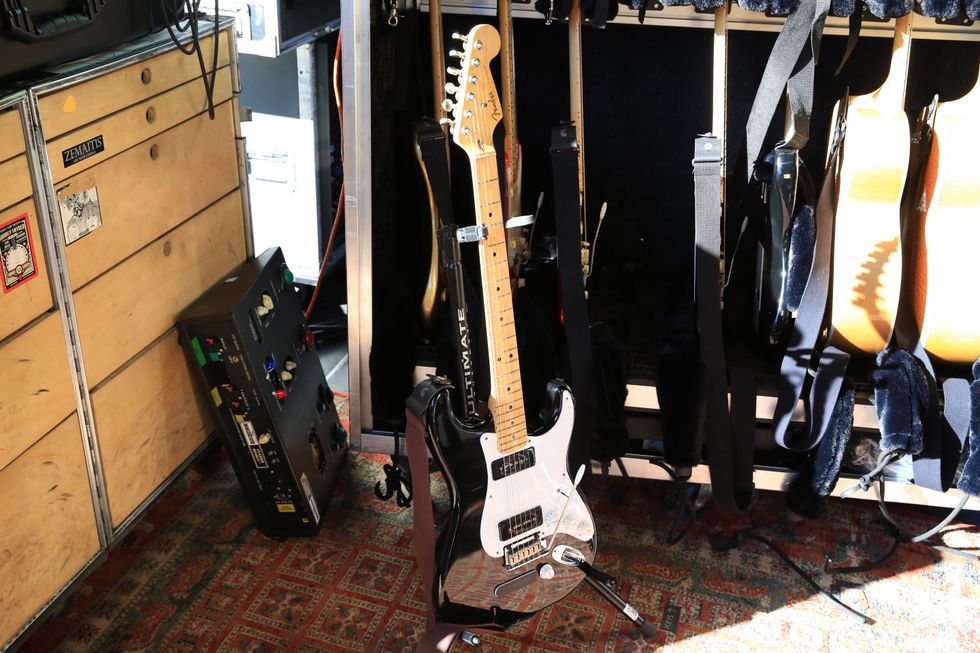
This skinny-fret Strat is loaded with P-90s in the bridge and neck, but the neck pickup is purely cosmetic—unwired and used as a killswitch.
The Quiet One
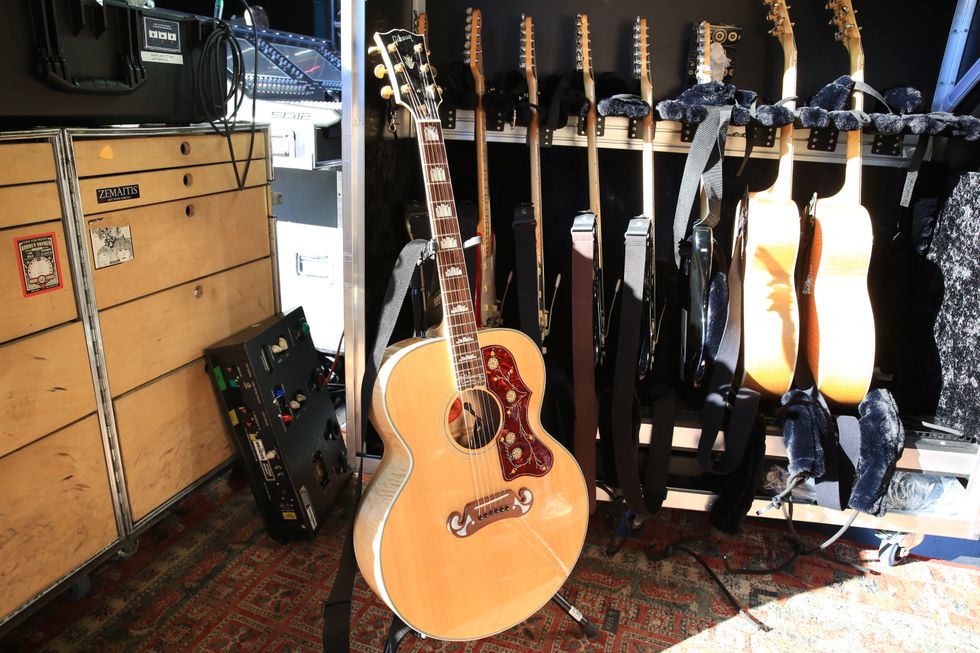
Townshend has been using Gibson J-200s forever, and this ’90s model has a Fishman Ellipse system, plus a Piezo under the bridge. It’s in standard tuning, while a signature-model backup lives in D–G–D–G–B–C. The backup has D’Addario strings (.012–.056) while the main axe has .012–.053 D’Addarios.
Addition from Alessandro
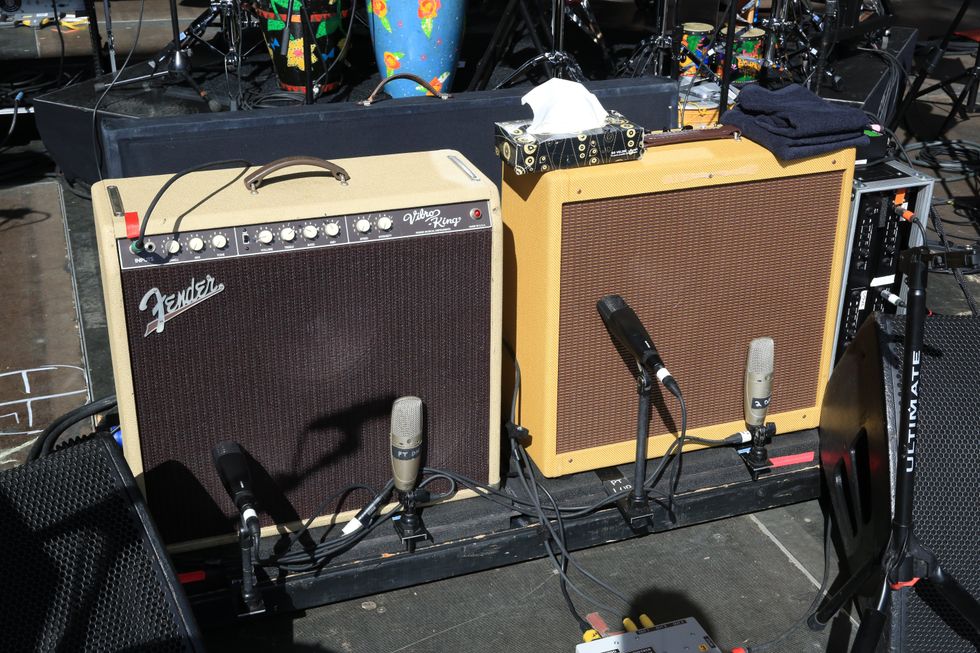
Townshend has been relying on Fender Vibro-Kings since the ’90s, and this one’s been treated to new filter caps, speakers, pots, and tubes. Law notes it’s fiddly to dial in, but always sounds great. Usually, Townshend runs a 2x12 cabinet beside it, but a desire for more control led them to have George Alessandro construct a Fender Bandmaster replica, with a 2x12 configuration.
Pete Townshend’s Pedalboard
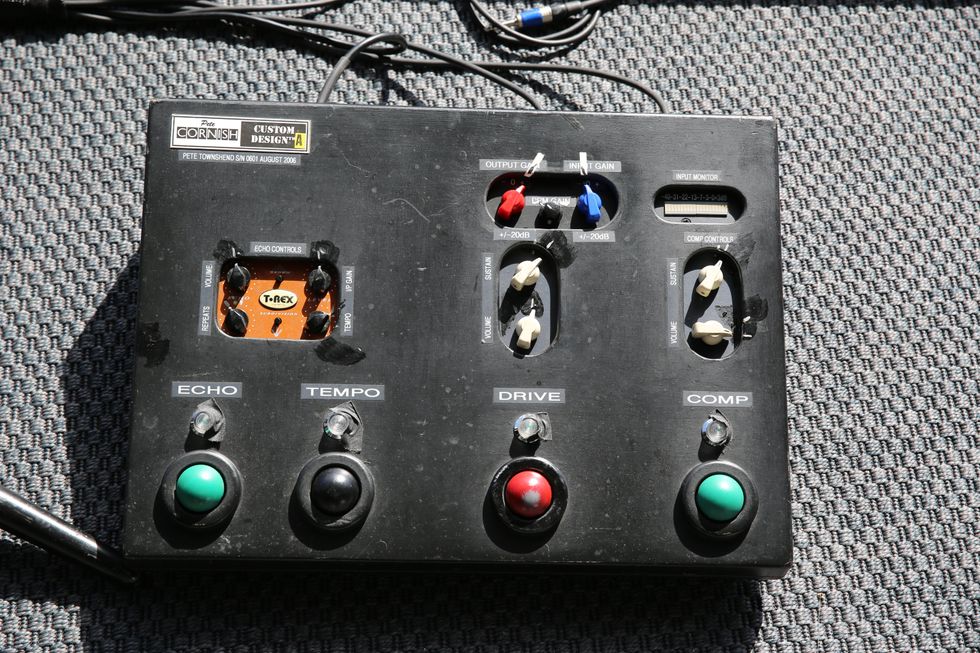
Pete’s guitars run into a Pete Cornish AC Powered 3 Way Split box, then onto a very custom Cornish-built pedalboard. Inside are just three circuits, pulled from their enclosures and wired up by Cornish: a T-Rex Effects Replica, a Boss OD-1, and a Demeter Compulator. Simon Law’s predecessor, lifelong Townshend tech Alan Rogan, had Cornish build two of these; the backup stays on hand in case of emergency. The board is also outfitted with a top-notch power supply and buffer circuit, plus the nifty “Dr. Who-style” footswitch buttons.
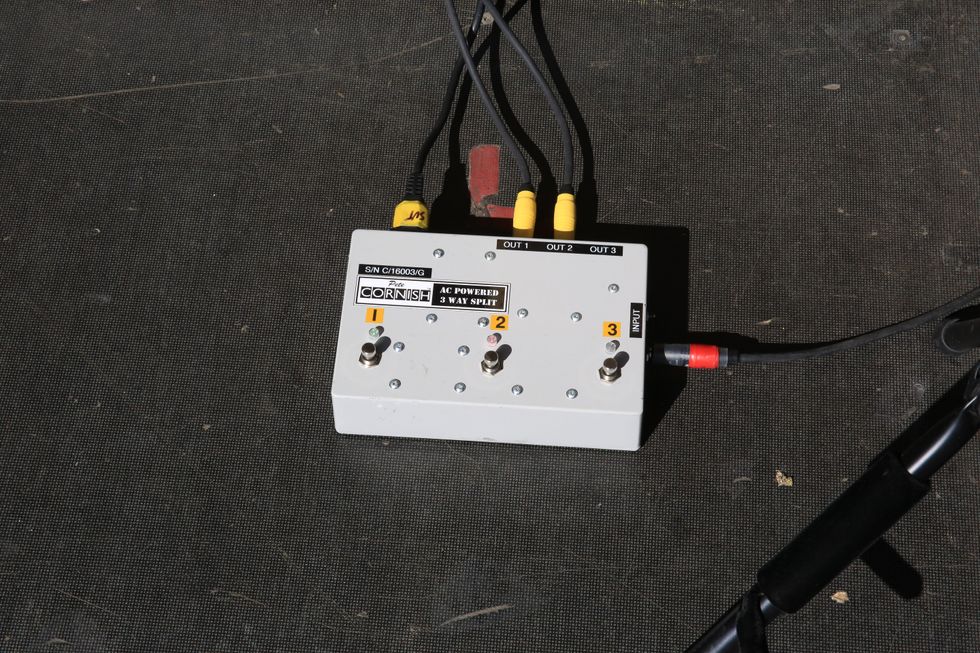
Button’s Best
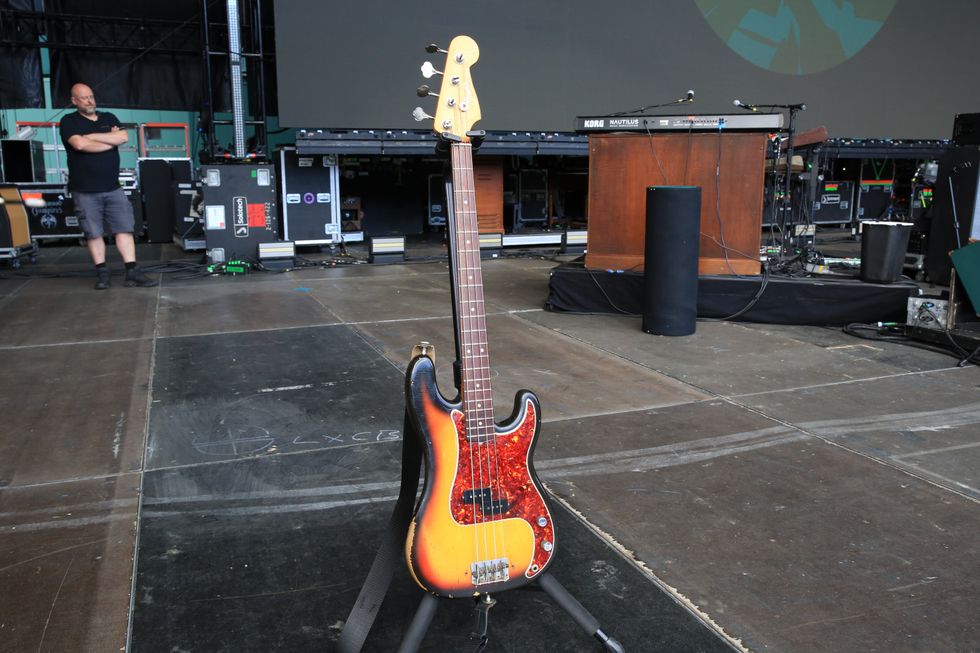
This bass, says Button’s tech Joel Ashton, is perfect. Snagged by Button in the late ’90s in Hollywood, it’s a 1965 Precision that’s been beautifully aged, and is generally used for the entire show. It’s kitted out with a Hipshot system on the D string (which drops to D flat for “Eminence Front”) and Apex strings, which Button strikes with both picks and fingers.
Mega-Monitor
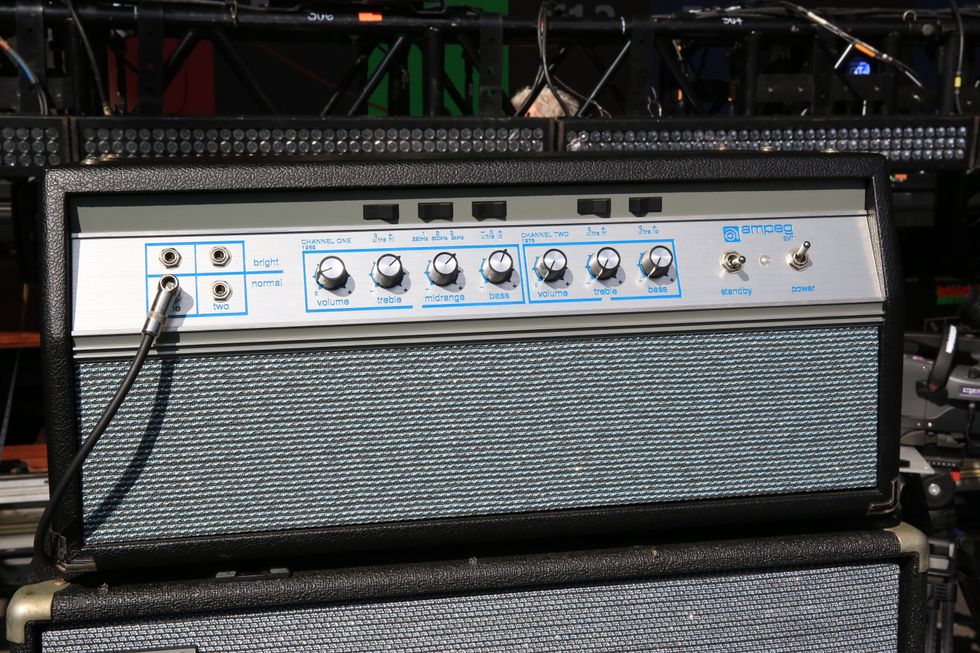
This classic Ampeg SVT is used solely as an onstage monitor for Button.
Jon Button’s Pedalboard
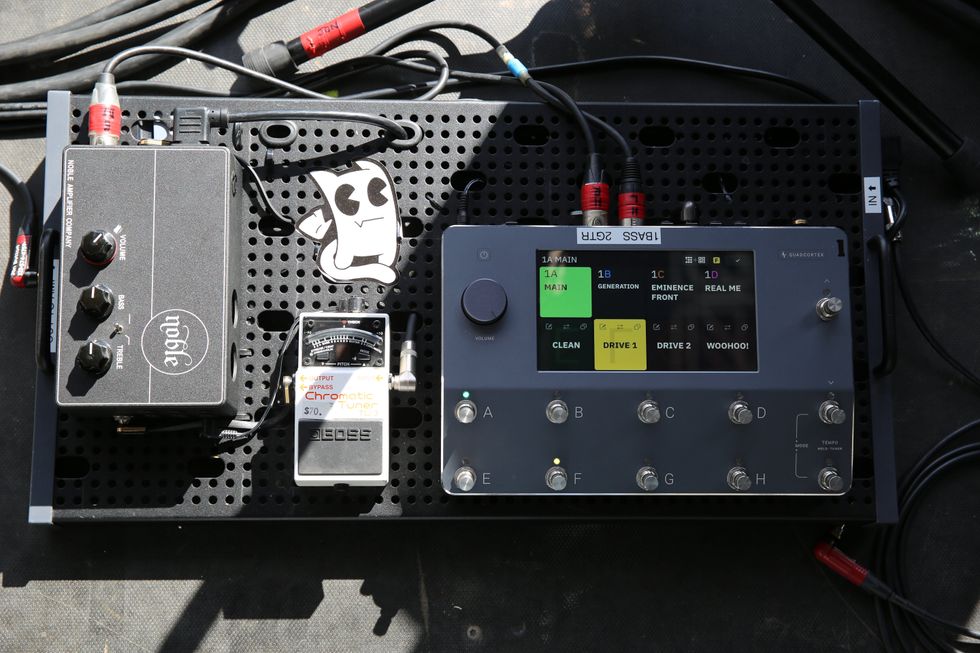
Button runs three signals to front of house: one from his Noble Preamp, and two from his Neural Quad Cortex. One of the Neural’s signals runs a stock Ampeg SVT model, and the other is an emulation of Pete Thorn’s Suhr SL68, plus four preset drive levels that Button can switch between as desired. Front of house blends the signals as they see fit.

Reverb Therapy, Part 1
Reverb is one of the most powerful colors in our palette. We all know that moment when you feel the need to add some to your tracks—whether you’re recording and looking for an inspiring new dimension, or you’re mixing and require that extra touch of spatial magic. But why are there so many options? With literally hundreds of convolution, algorithmic, plate, and spring reverbs out there, it’s easy to feel an overwhelming sense of anxiety. Knowing the differences between types of reverbs and why certain units have become legendary can significantly elevate your recordings and mixes. Tighten your belts, the Dojo is now open.
The Starting Point
I’m going to sidestep the deeply fascinating and well-researched physics and psychoacoustics behind the phenomena of reverb. Instead, we’ll focus on practical strategies for how to choose the right one (plate, spring, algorithmic or convolution), and why some types are more prized than others.
Unless you’re situated in an anechoic chamber or an open field, every environment, from a hall closet to a canyon, has reverberant properties. But before the advent of reverb chambers and plate reverbs, it was a fixed byproduct of the space where the recording took place—think of the 1961 concert document, Miles Davis at Carnegie Hall, for example. Not all concert halls lent themselves to studio quality recordings, though, especially for genres of music other than classical or opera.
After 1947, the only way to add artificial reverb was to employ a chamber—literally, a specially built room with a speaker and microphone(s). Recording studios started to develop their own echo chambers that gave a unique sonic fingerprint to the recordings, and we still prize certain studios—Abbey Road, Ocean Way, Blackbird, Motown, Sound City— for their chambers, many of which are now available in the forms of plugins.
All that began to change in 1957, in Berlin, with the advent of the EMT 140 plate reverb. EMT’s solution was brilliant: suspend a large sheet of steel under tension, feed sound into it through a transducer, and capture the shimmering decay with contact mics. The EMT 140 gave engineers long, smooth tails that felt lush without overwhelming the source. Vocals in particular took on a glow that instantly elevated a mix. That unmistakable “plate vocal sound” defined the recordings of countless artists, from Frank Sinatra to the Beatles to Jimi Hendrix to Pink Floyd. Even today, plug-in makers such as Universal Audio, Waves, and Arturia are still chasing that magic, and multiple original units are still widely used by world-class studios.
“Unless you’re situated in an anechoic chamber or an open field, every environment, from a hall closet to a canyon, has reverberant properties.”
Fast forward to 1976, and EMT again pushed things forward with the EMT 250, the first commercially available digital reverb—for the princely price of $20,000 (over $114,000 today). Only 250 units—a mini refrigerator-sized machine with controls that looked like they came off the dashboard of a spaceship—were produced. What made the EMT 250 special wasn’t just its novelty, but the way its algorithms shaped reflections. It had a character all its own: warm, slightly grainy, and wonderfully musical. Almost a proto mutli-effects processor, it didn’t try to mimic reality so much as create a believable illusion of space, and it did so with a tremendous personality. (The EMT 250 is currently available from Universal Audio as a plug-in for $249 street.)
Meanwhile, across the ocean in Massachusetts, Lexicon was hard at work refining digital reverberation. The Lexicon 224 (1978) was half the price of the EMT 250 and boasted a reverb range of 0.6 to 70 seconds. It also offered the first flexible and convincing Concert Hall, Chamber, Room, Plate, Rich Plate, and Inverse algorithms. It was the studio reverb of choice until the 480L (1986) which, with its updated signal processing power, became the studio staple—and for good reason. Chances are it’s the main big reverb on classic U2, Talking Heads, Rush, Prince, and Peter Gabriel records. The 480L’s algorithms remain benchmarks: dense, lush, and capable of everything from subtle ambience to stadium-like grandeur. Even today, if you walk into a top-tier studio, odds are a 480L is still patched in.
I encourage you to set aside some time and get to know the differences between these four classic verbs, before we move on to another set in the next installment. They are all available in plugin format with fully functional trial periods. I’ll share my favorite reverbs in order of preference and application next month. Until then, namaste.
Peavey Rock Master Preamp Pedal Imposes Its Presence onto the Pedal Board
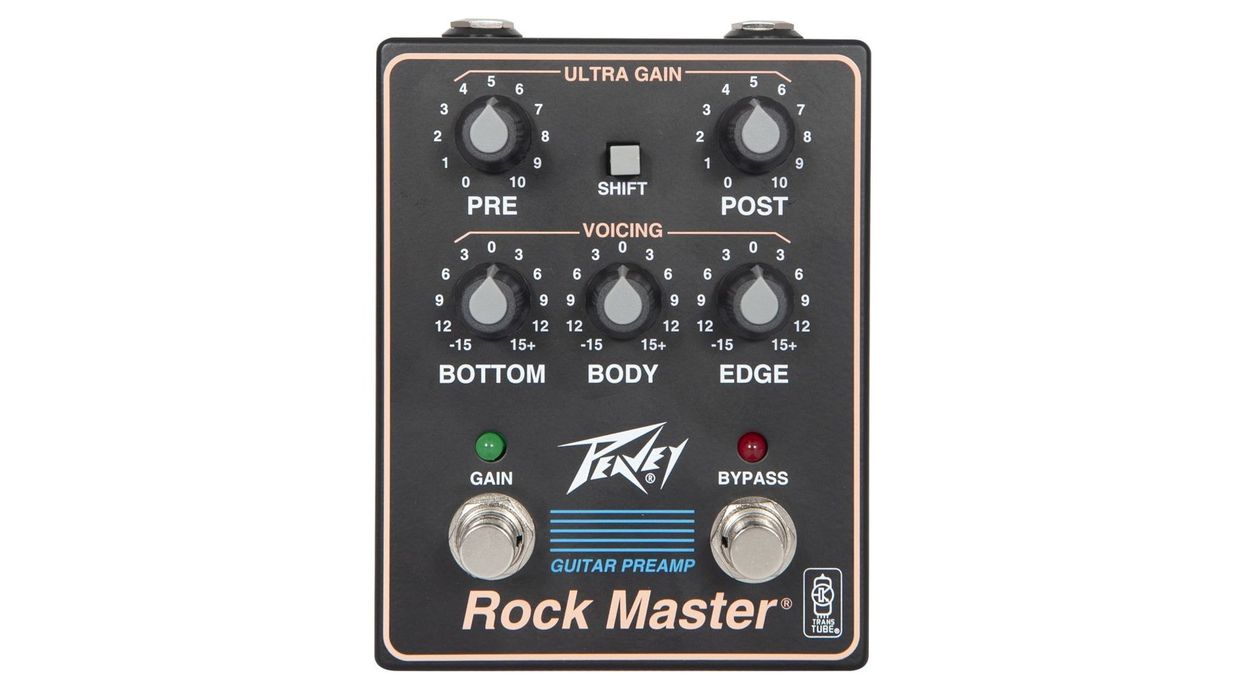
Peavey Electronics® is now shipping the latest in their new Legacy Series of pedals, the Rock Master® preamp pedal. This pedal delivers the highly sought after Ultra Gain tones of the early 90’s Rock Master Guitar Tube Preamp in a compact package small enough to fit in your back pocket. The pedal is now available worldwide through local and online retailers.
The original Rock Master Guitar Tube Preamp is what some consider to be the granddaddy of what became the Peavey XXX and JSX guitar amplifiers. Most notably, the Ultra gain section. The new Rock Master preamp pedal focuses on this Ultra Gain section and the units Voicing EQ. The units PRE and POST gain controls allow the user to control the amount of gain applied to the input signal via the PRE control and the overall output volume via the POST control. The active three band EQ/Voicing section allows players to fine tune their overall tone with BOTTOM, BODY, and EDGE controls. As it implies, the BOTTOM control is an active +/- 15dB shelving type tone control that varies the low frequency boost or cut. The BODY control is an active, peak/notch +/- 15dB tone control that varies the mid frequency boost or cut. And the EDGE is an active +/- shelving type control varying the high frequency boost and cut. Internally, it is Peavey’s TransTube® technology that brings it all together to create that groundbreaking Peavey Rock Master “Ultra” channel circuit.
Construction of the pedal uses a die-cast metal enclosure, fiberglass PCBs with 2-ounce copper and plated through holes on all components, high quality pots, switches, and jacks, and cosmetics reflecting the original preamp that influenced a whole generation of guitar amplifiers. The pedal can be used with either a 9v power supply or battery.
For more information, please visit www.Peavey.com
Retail: $199.99 USD

